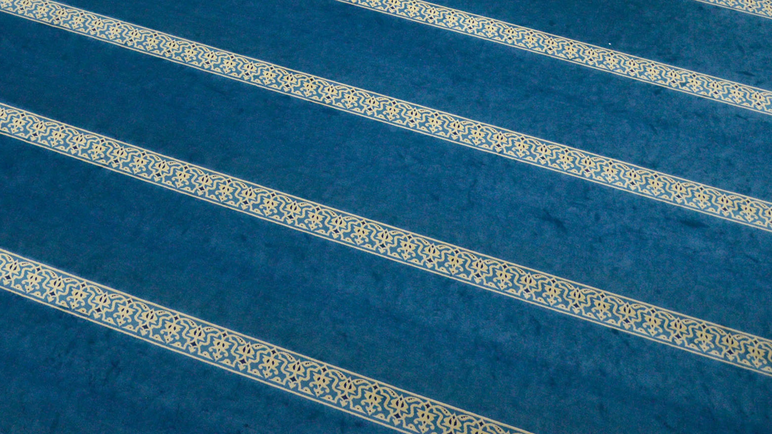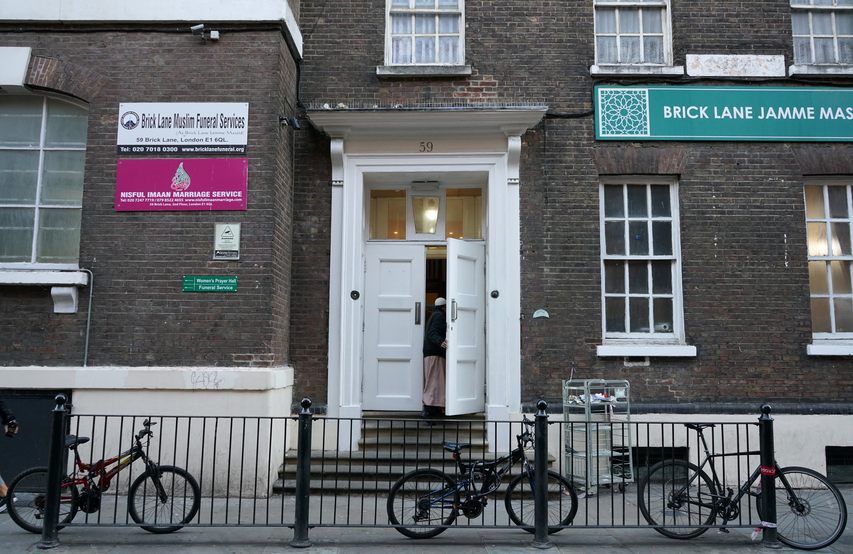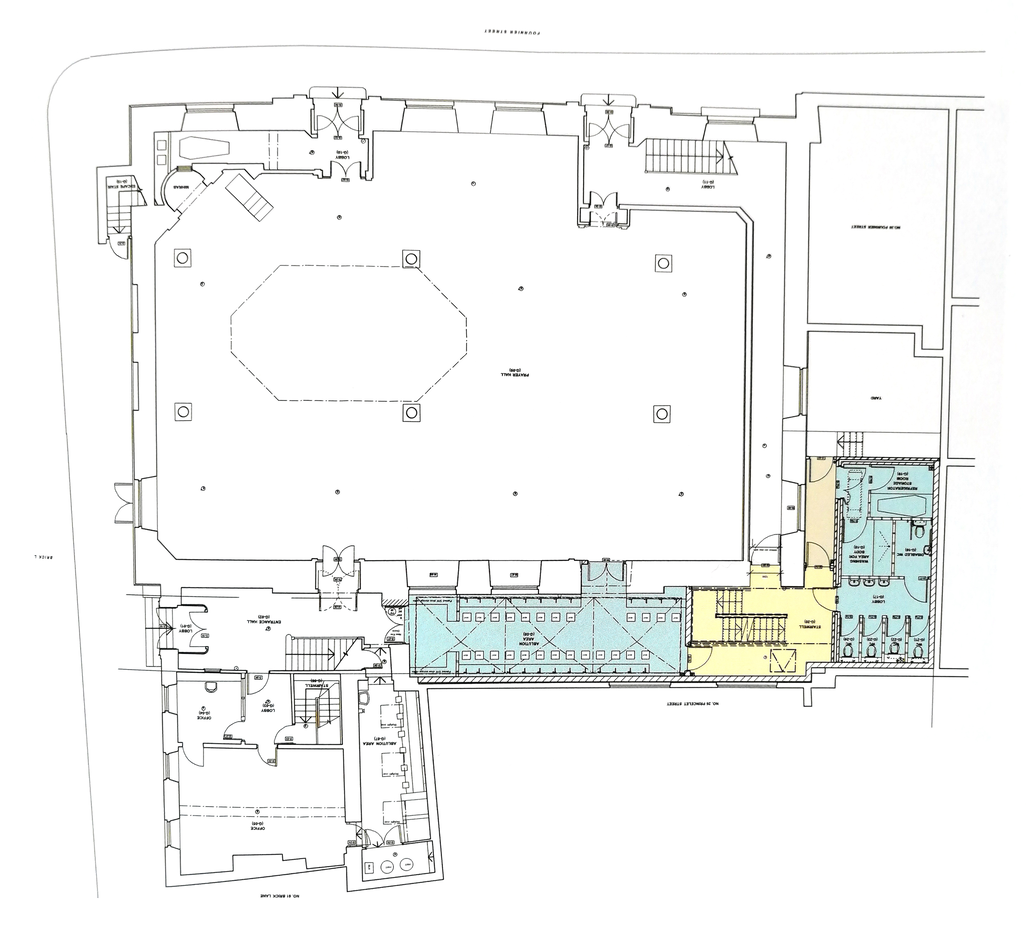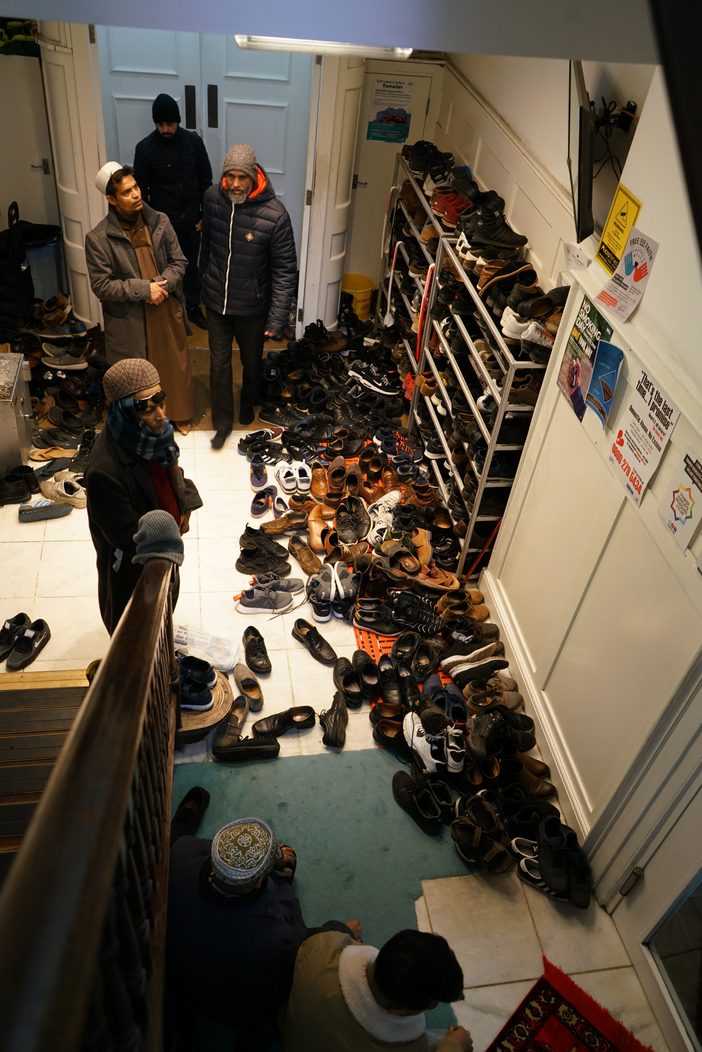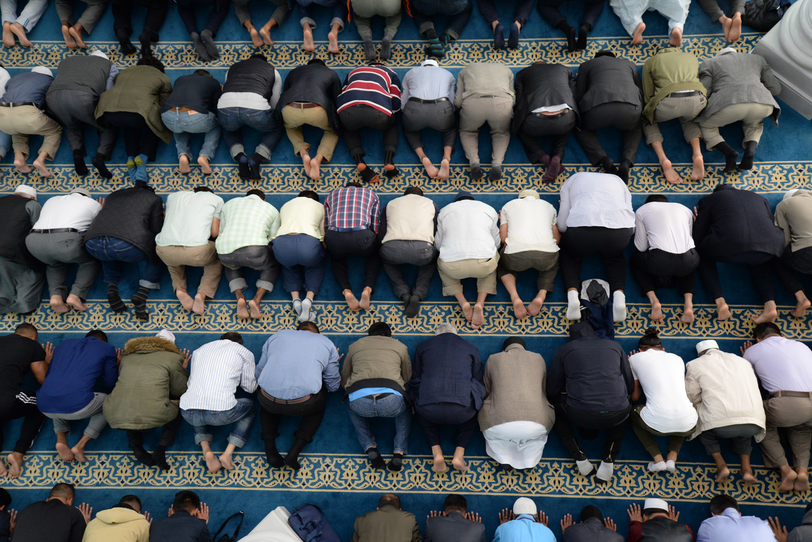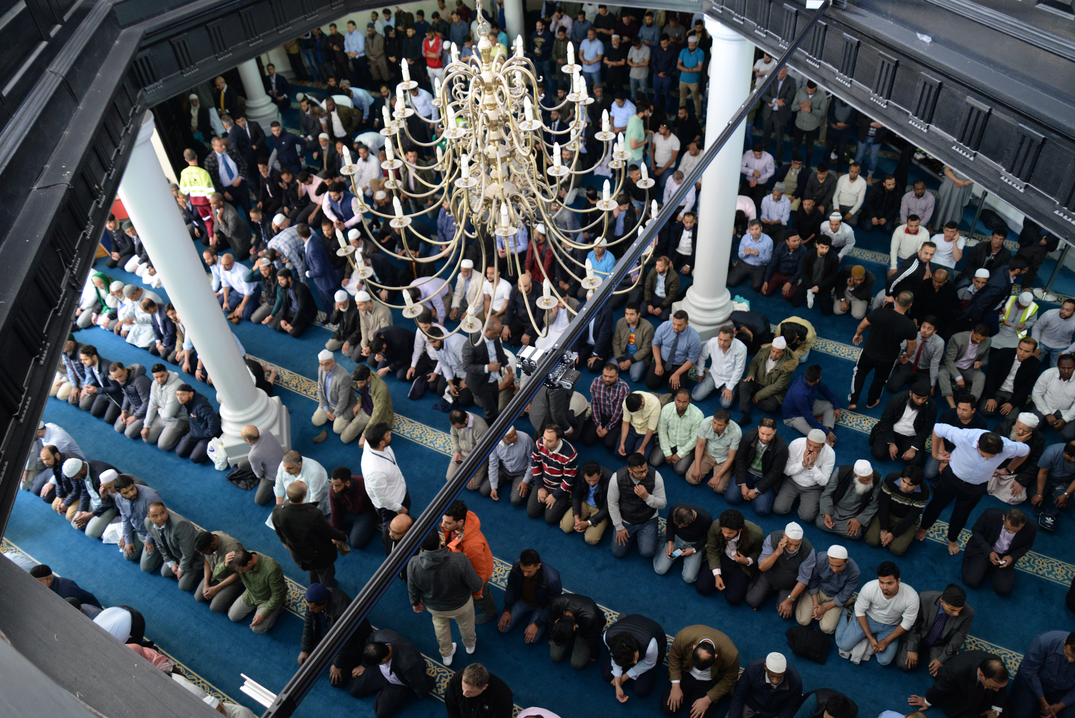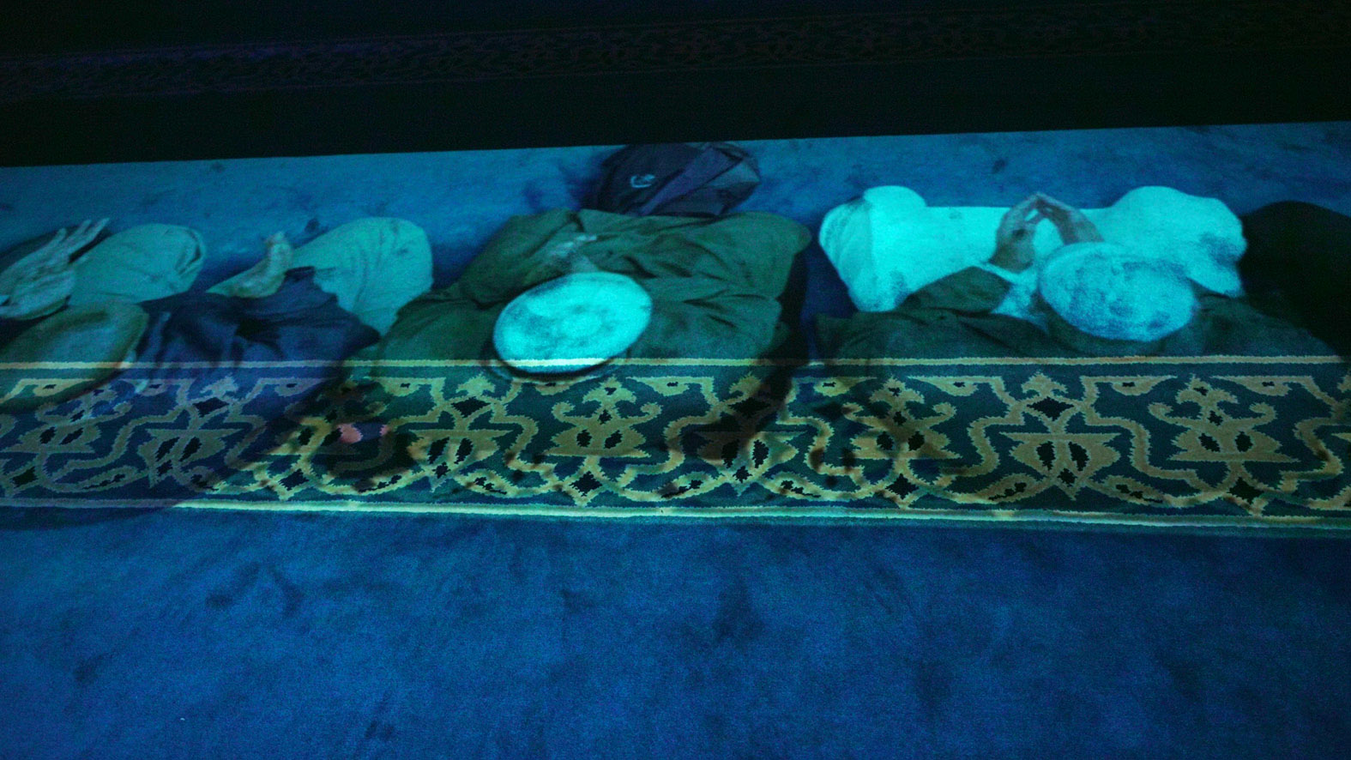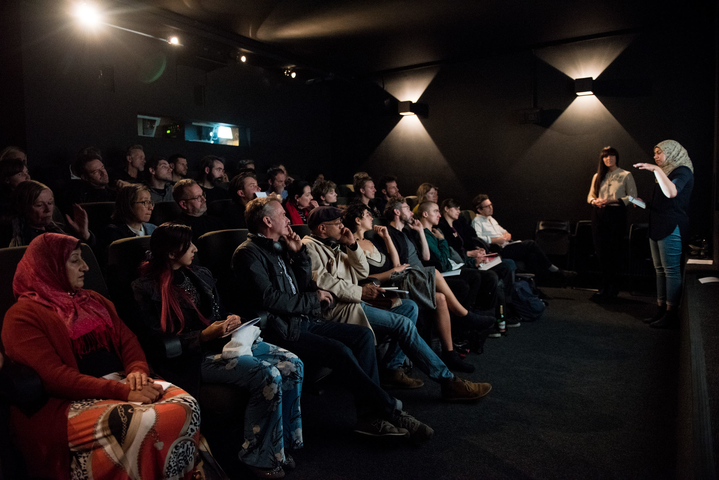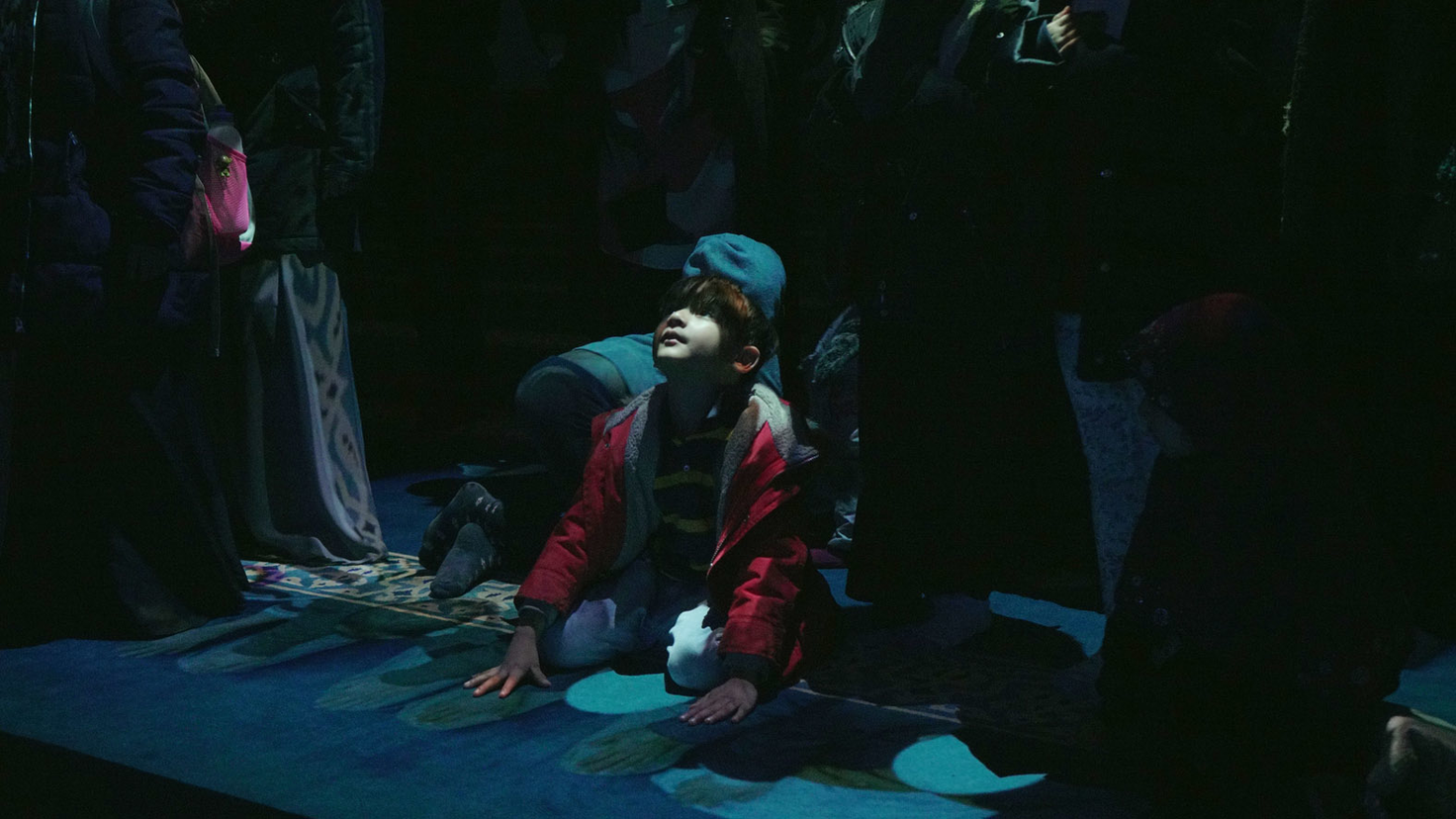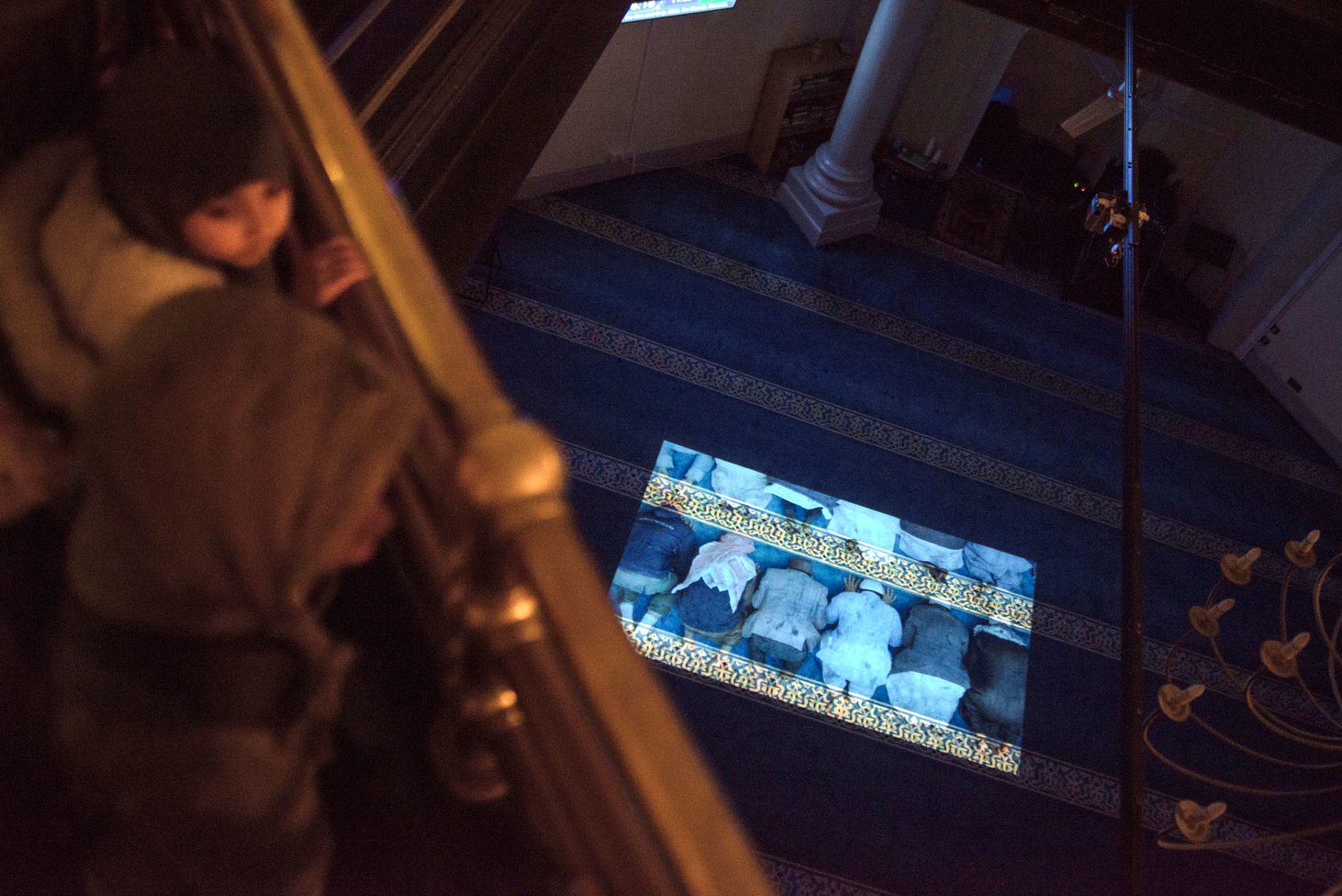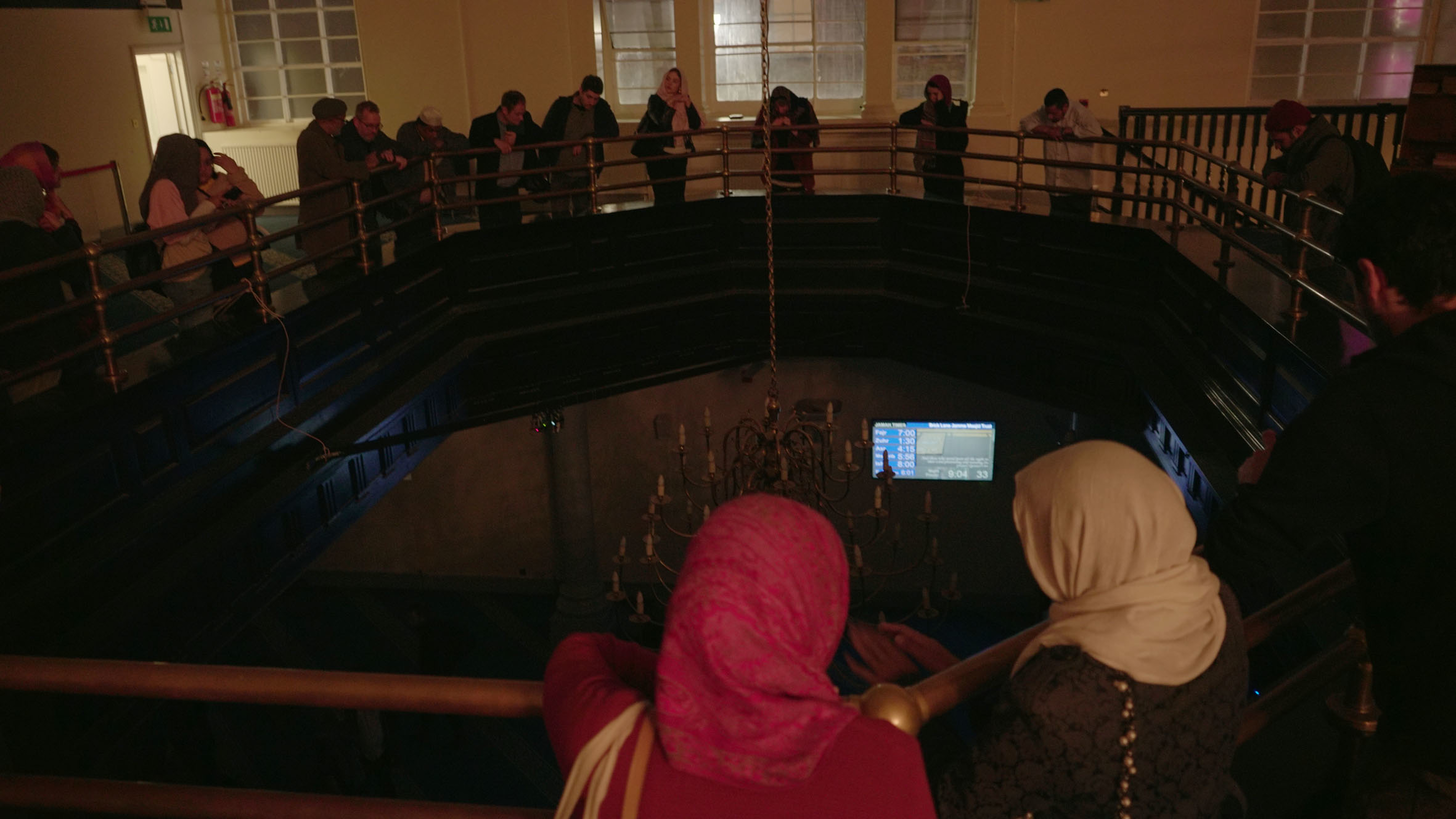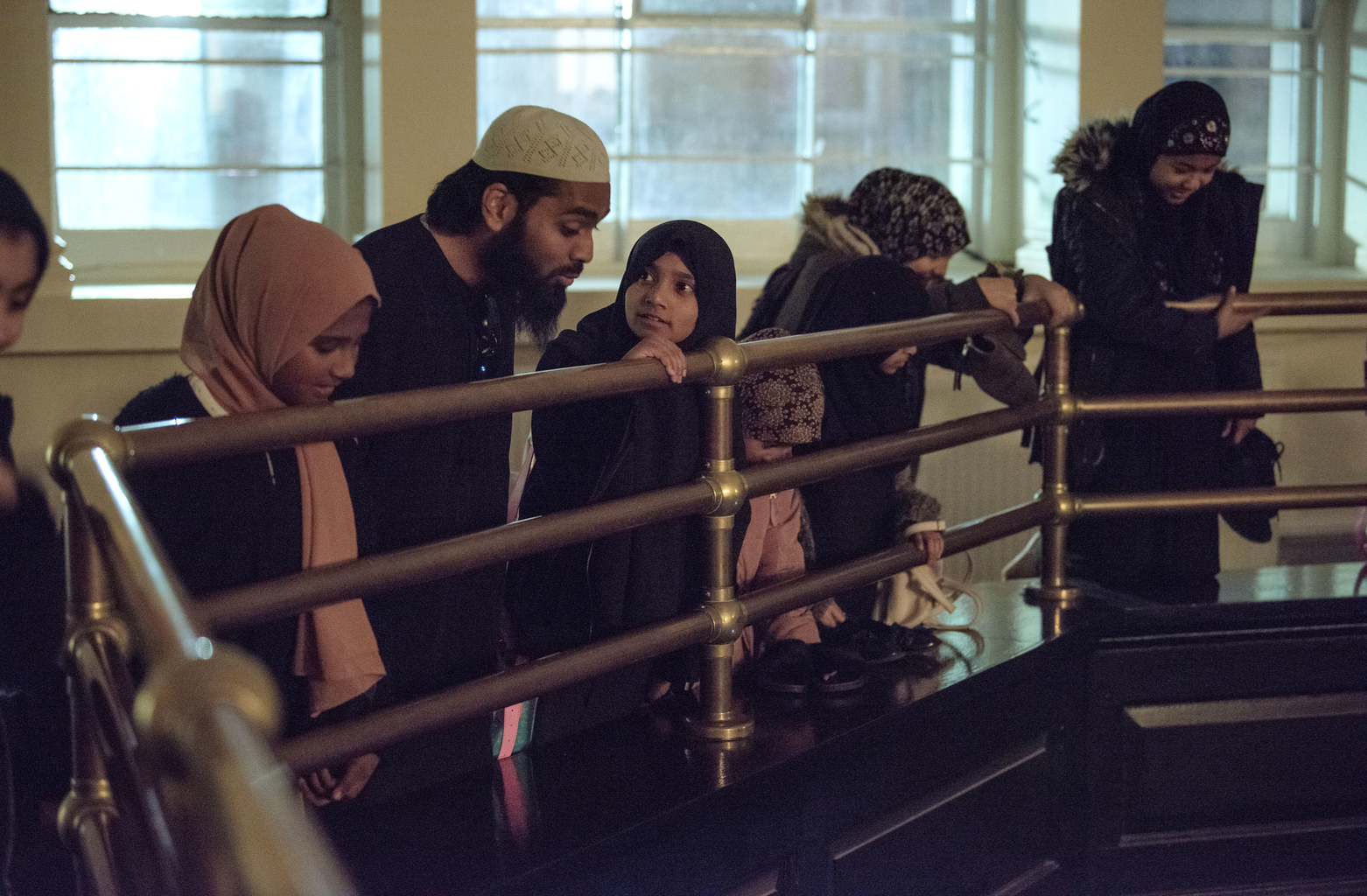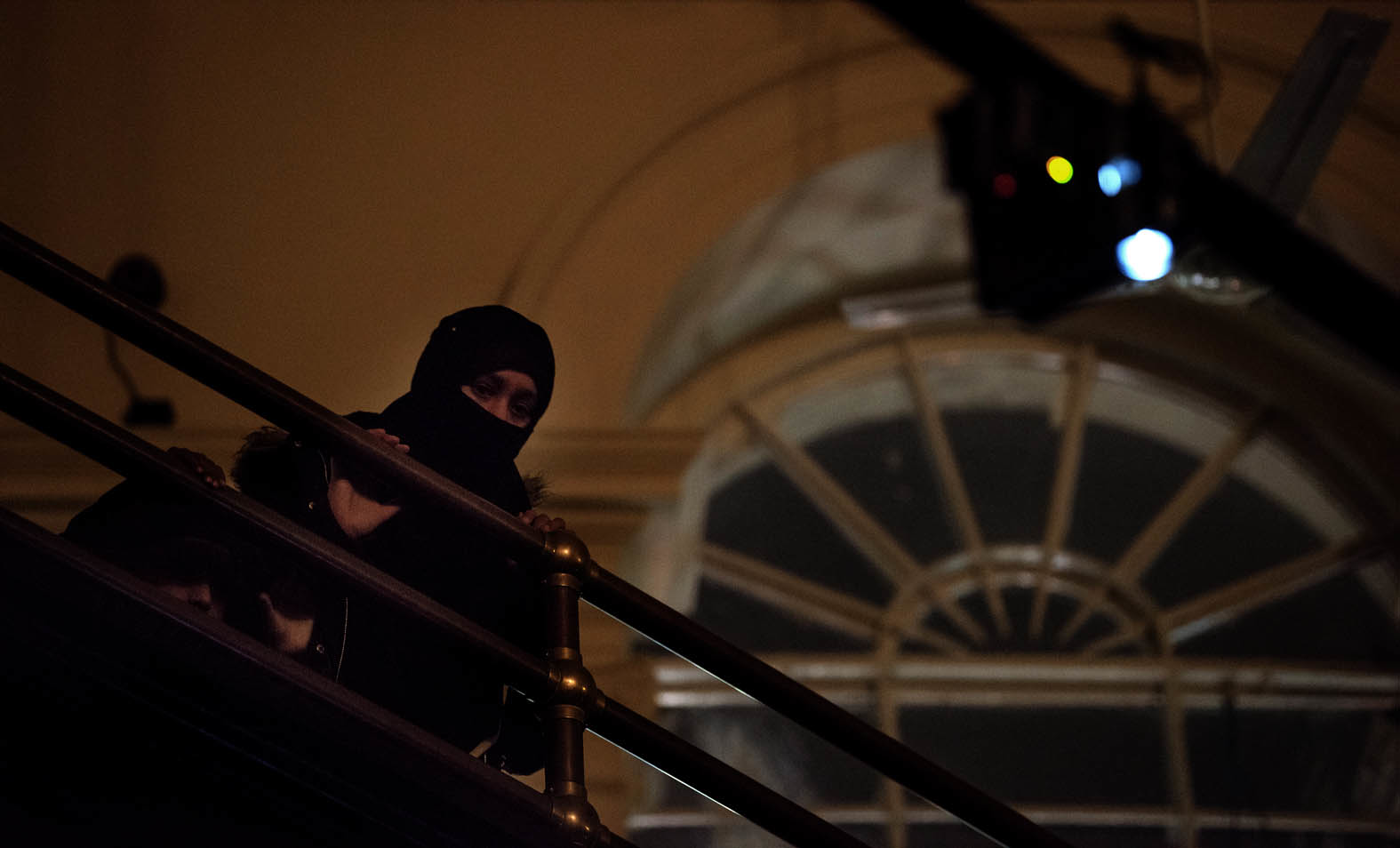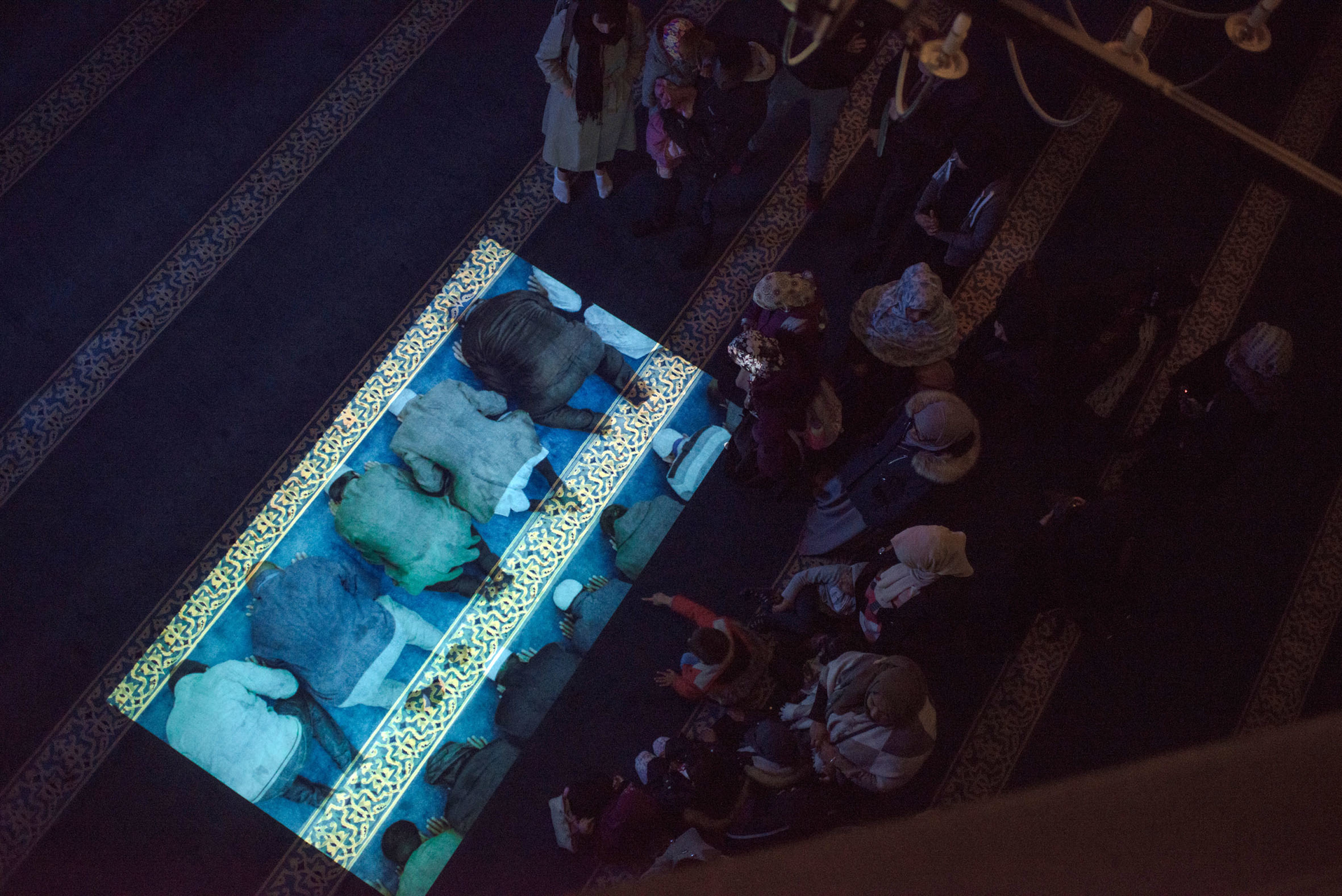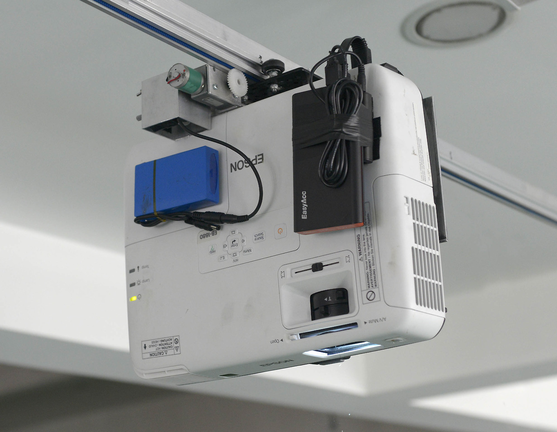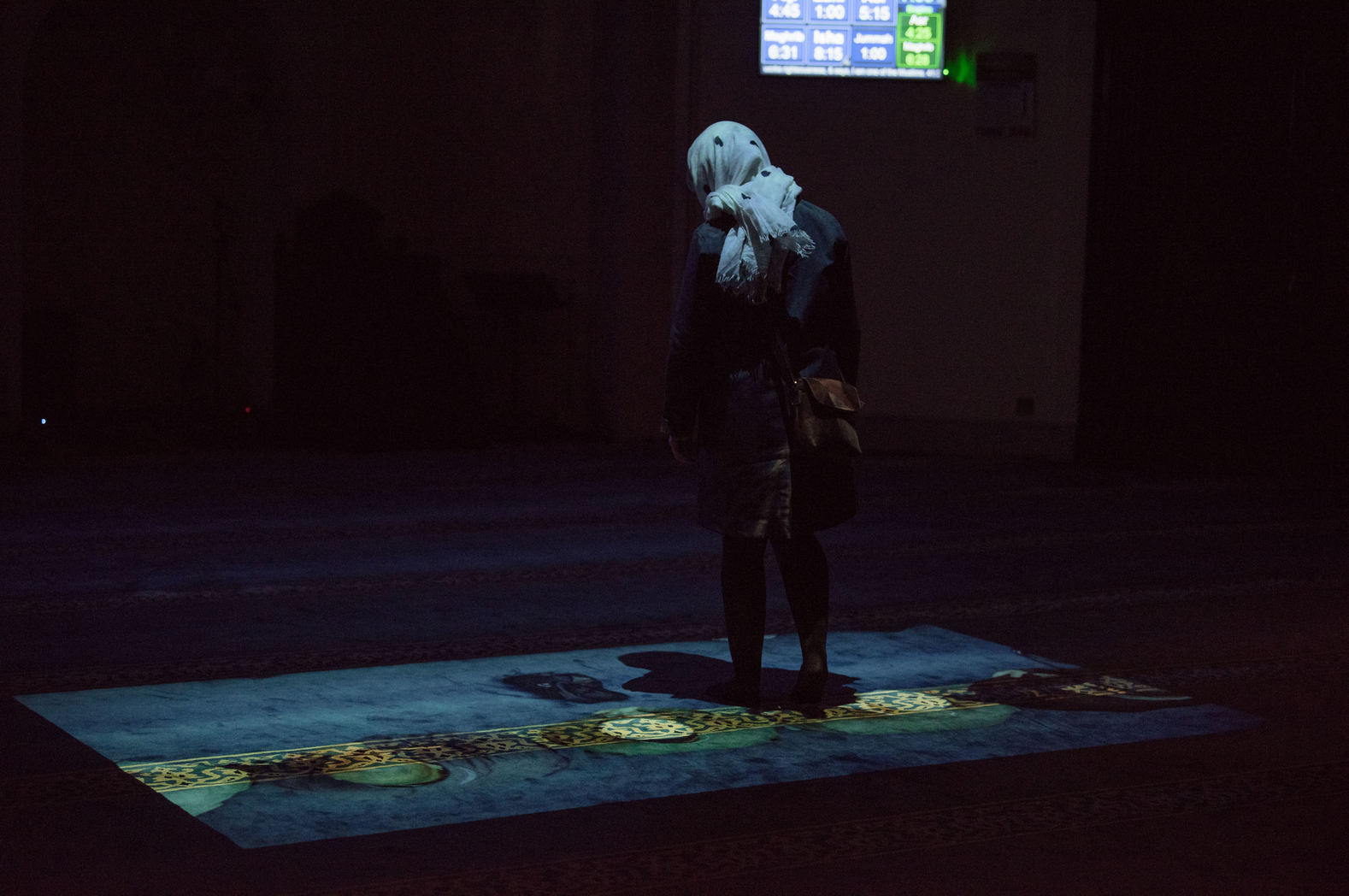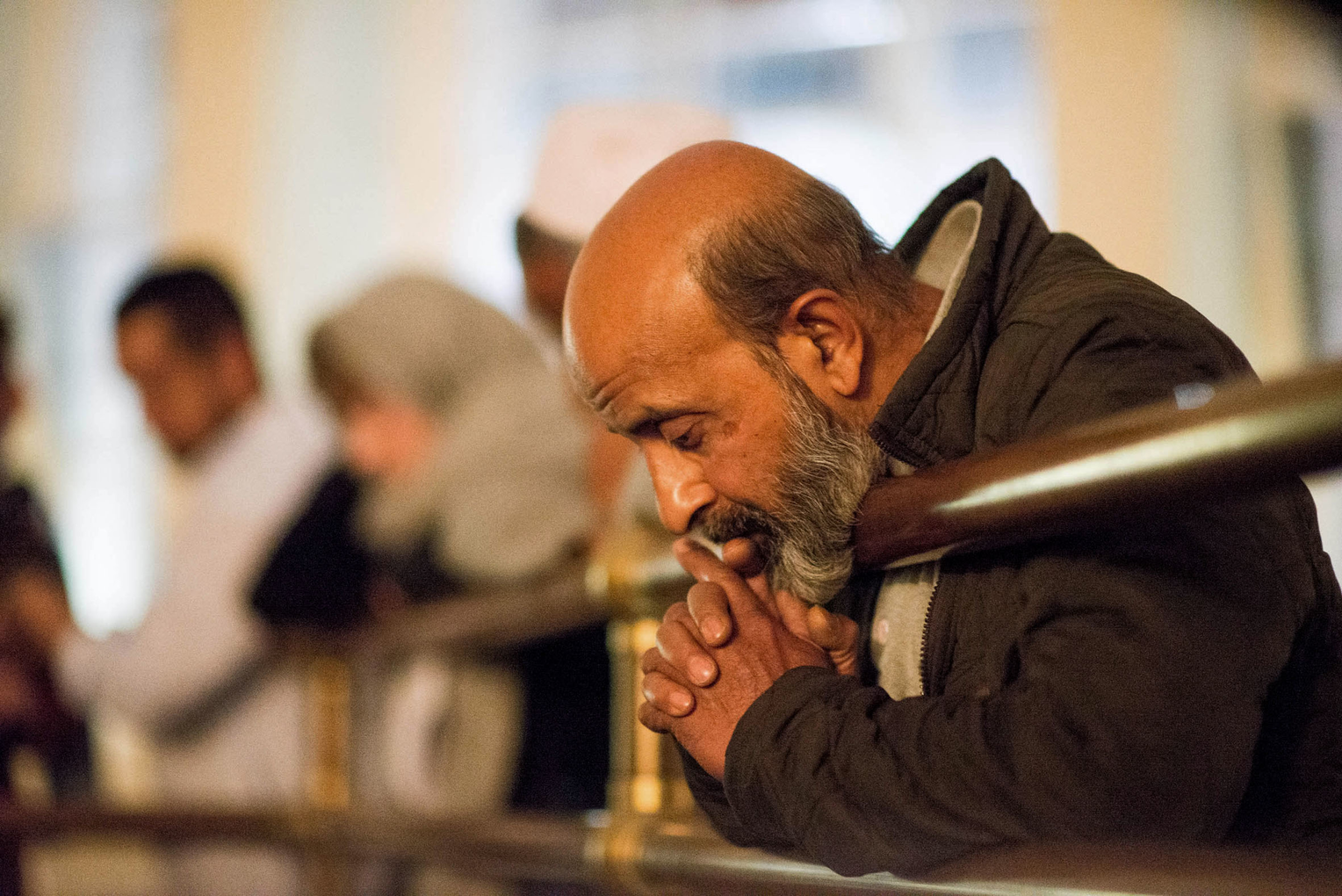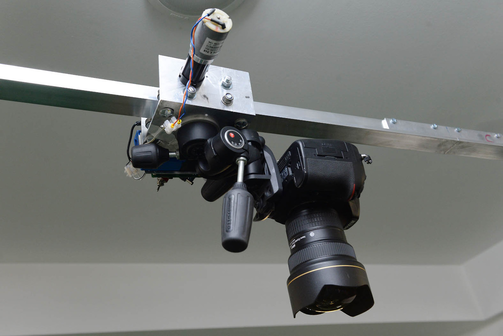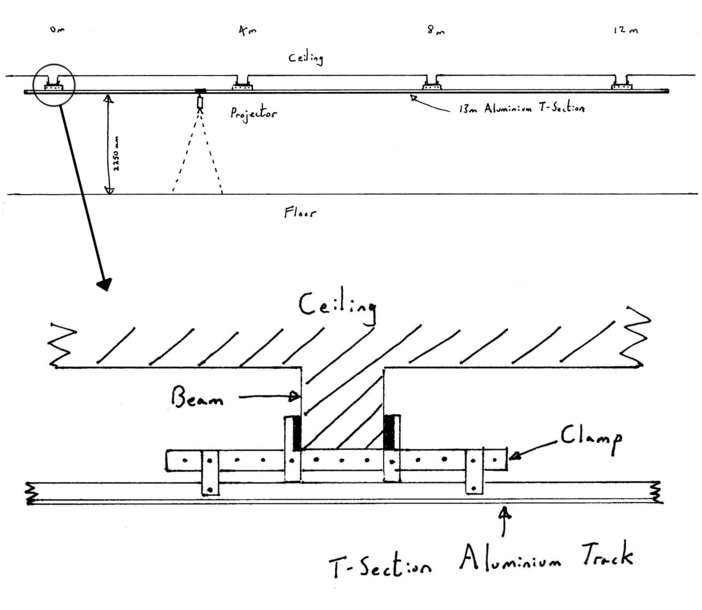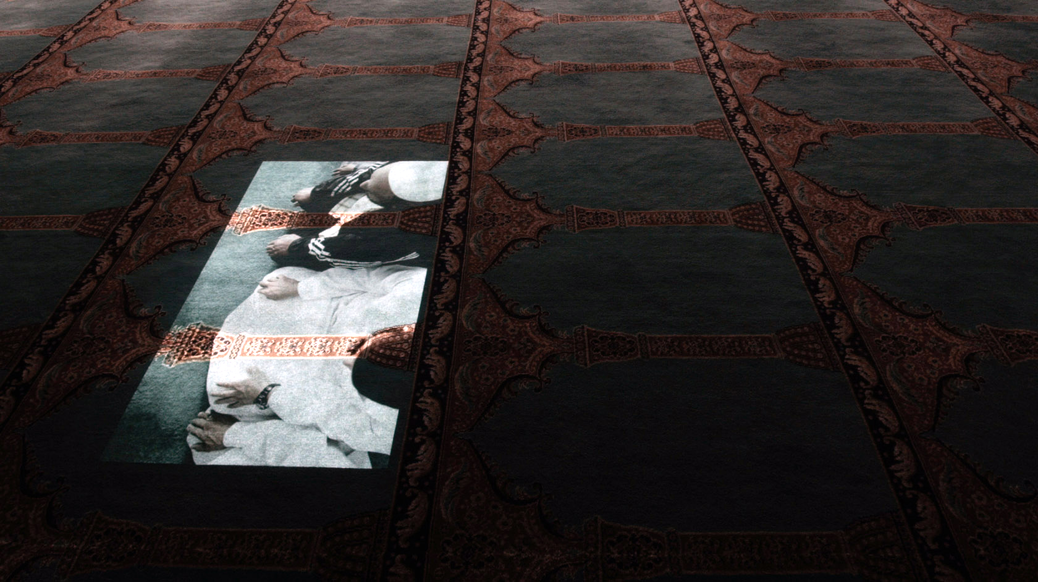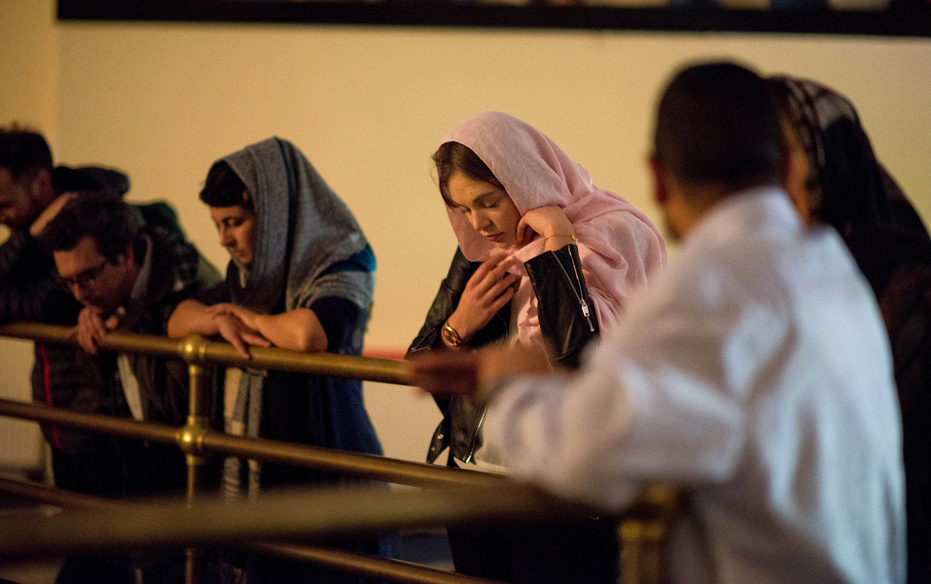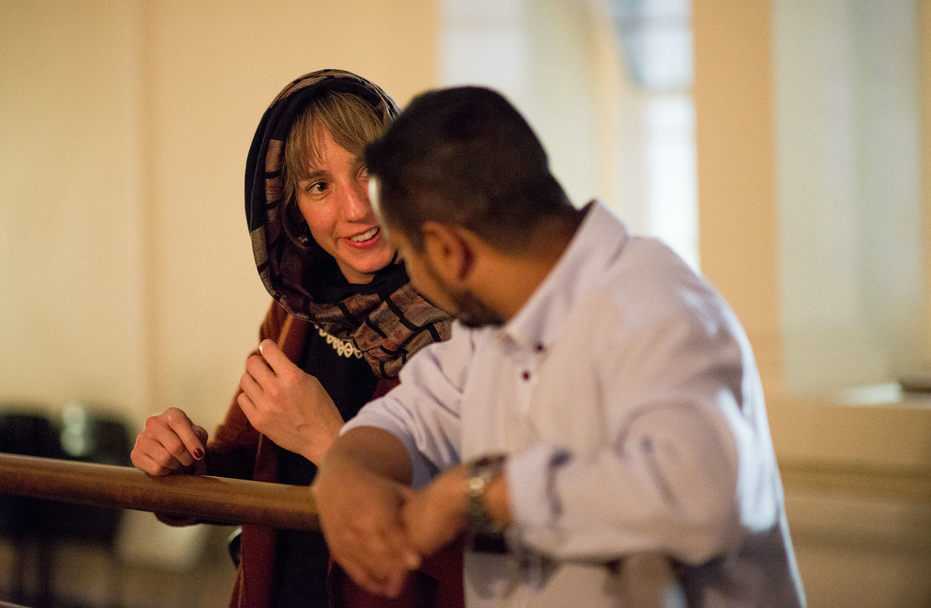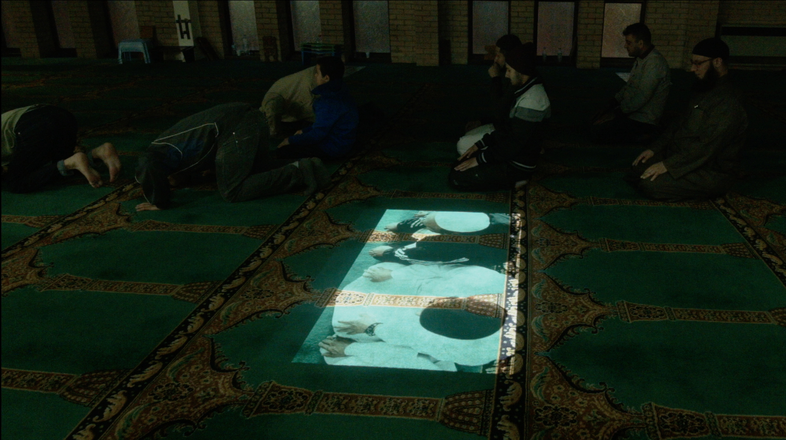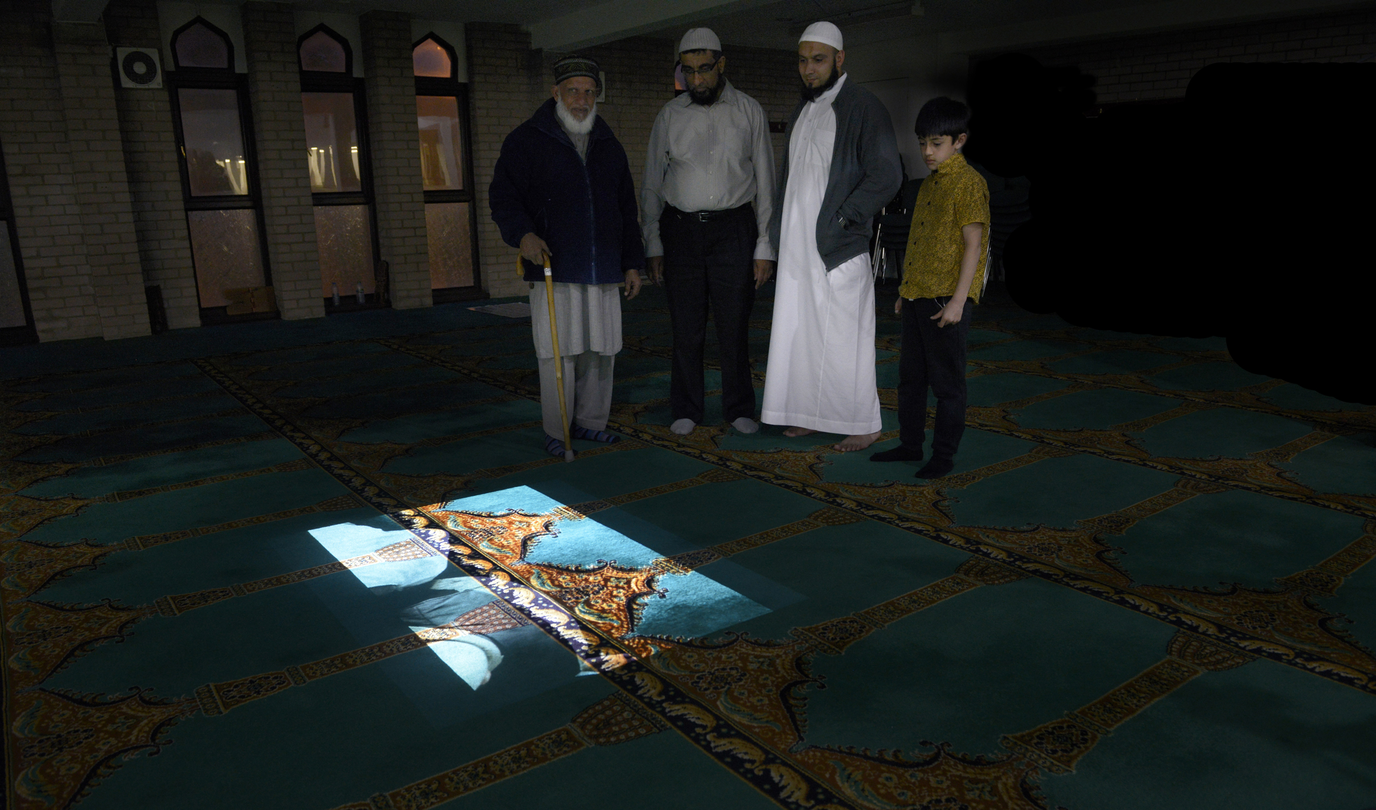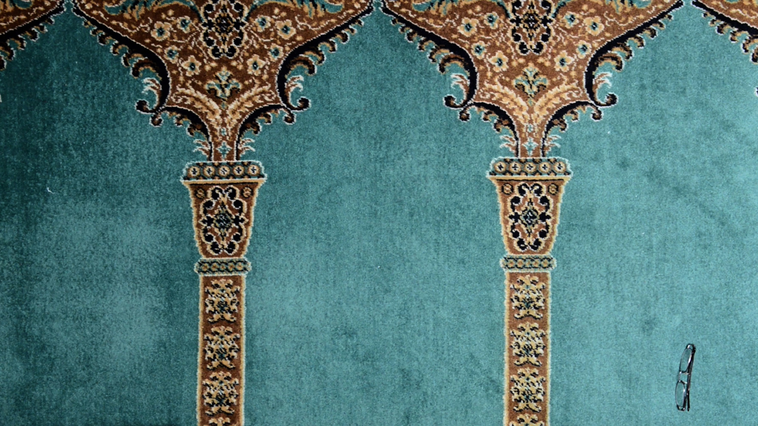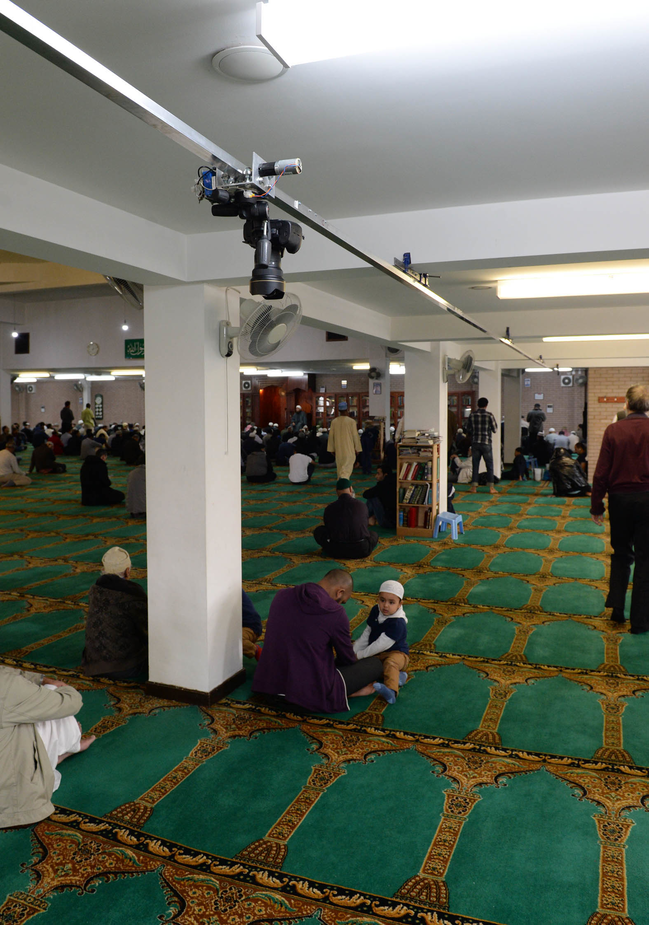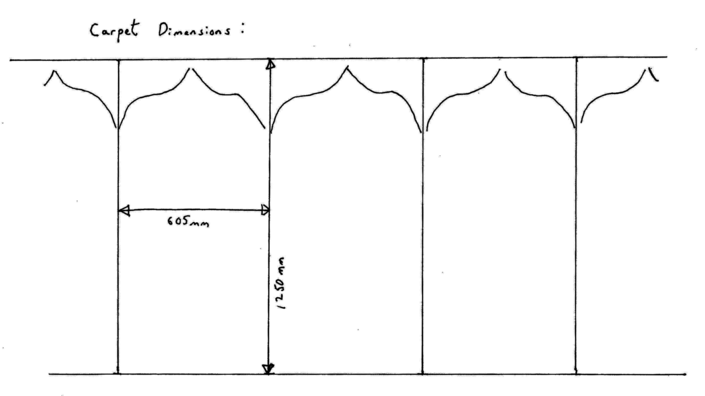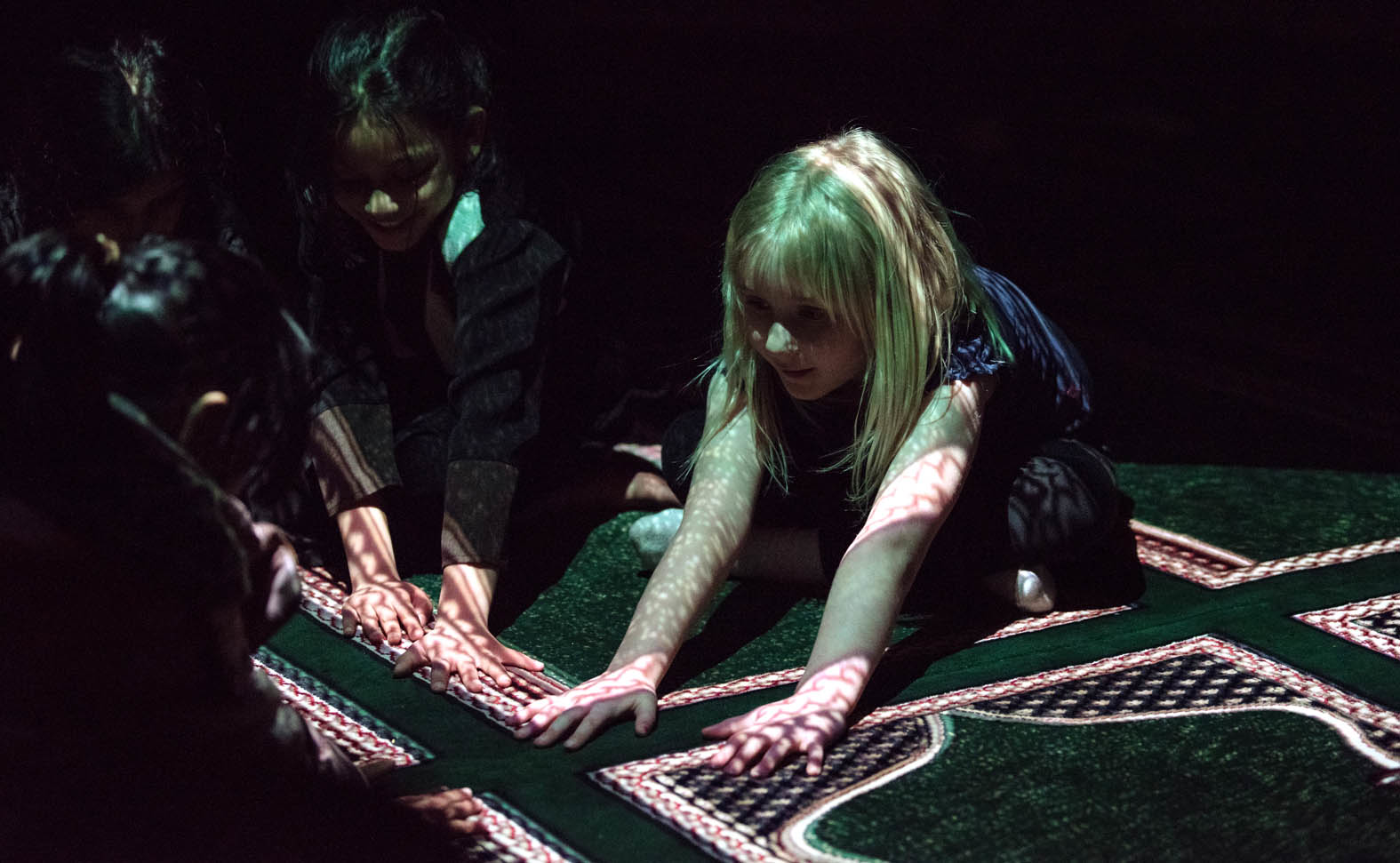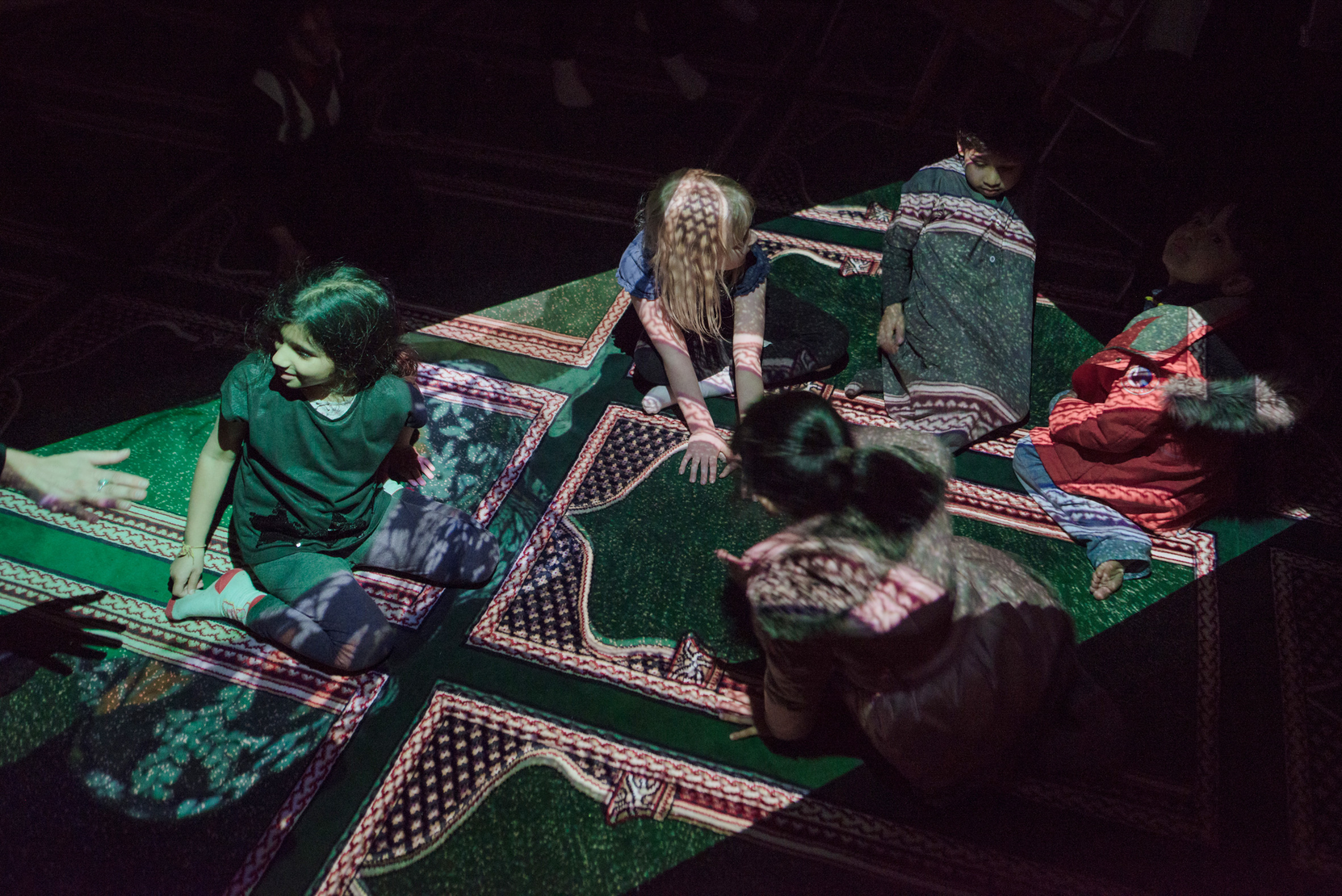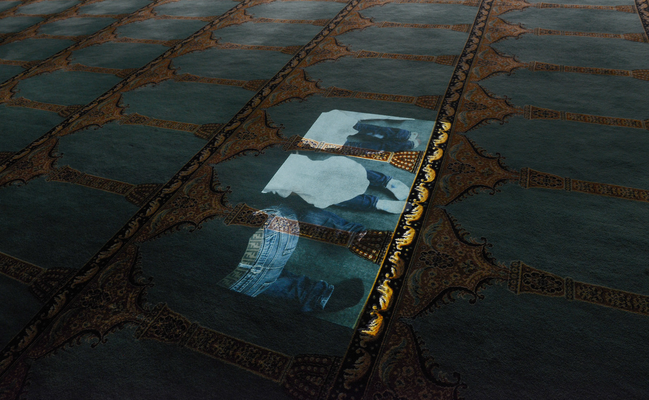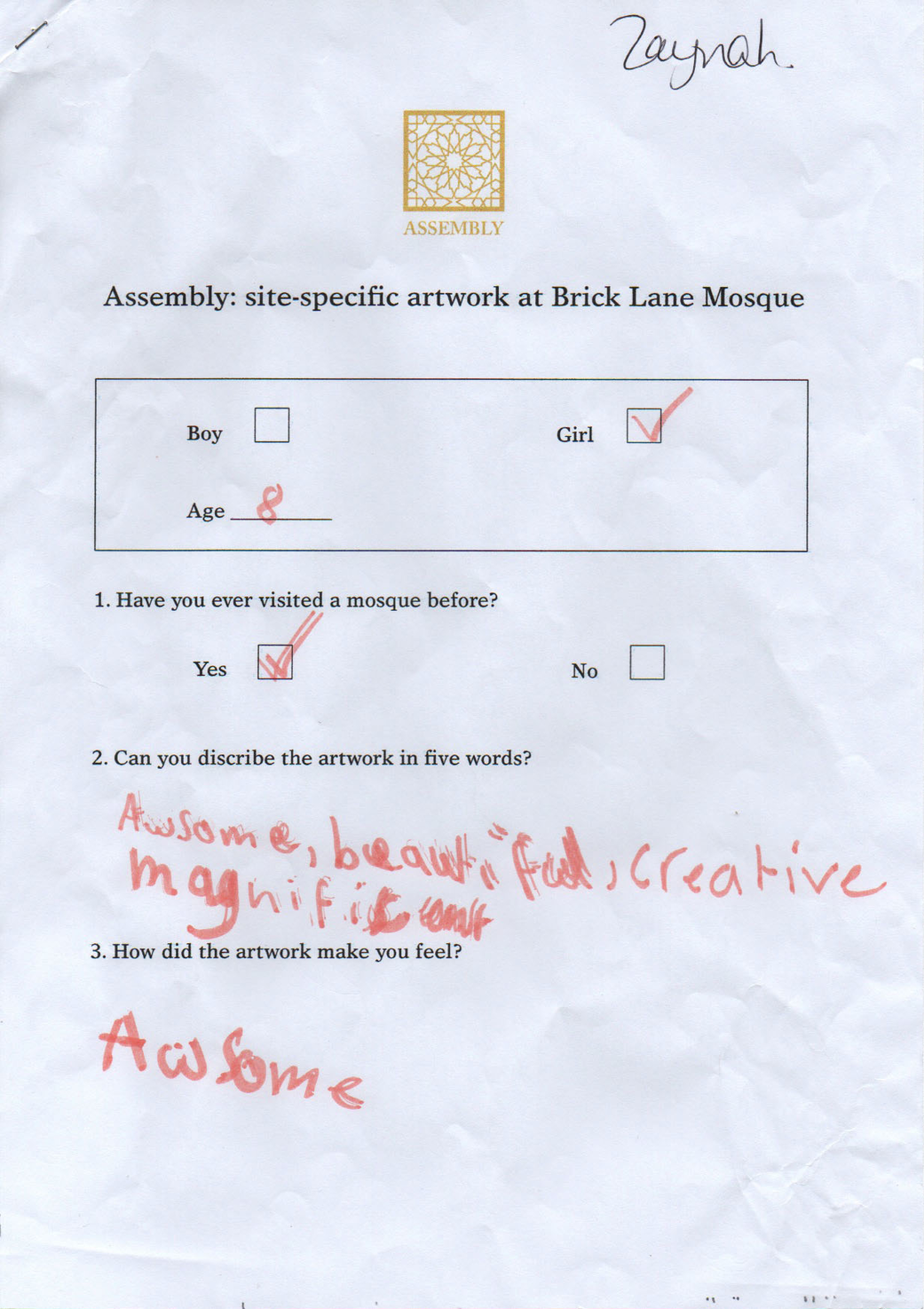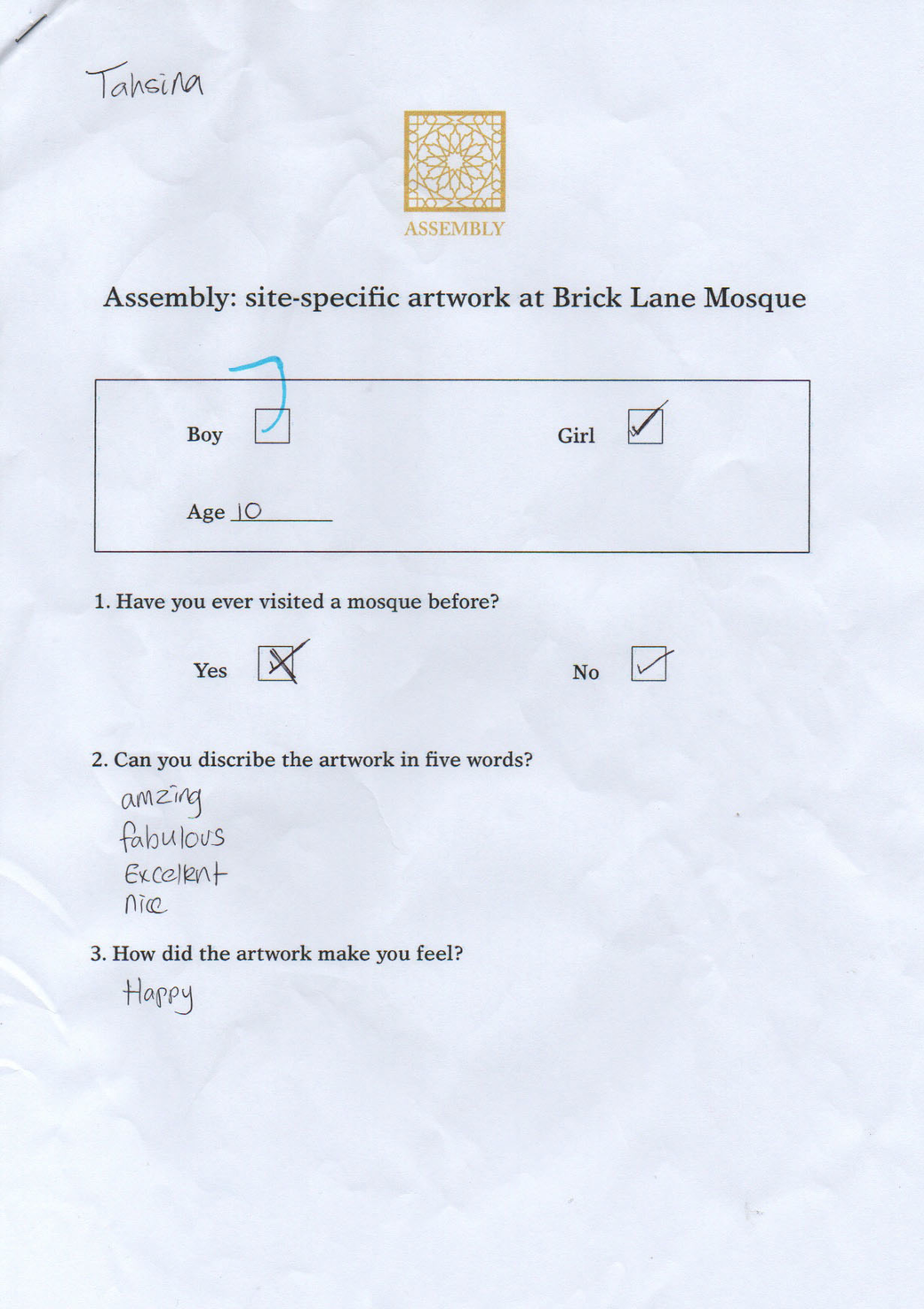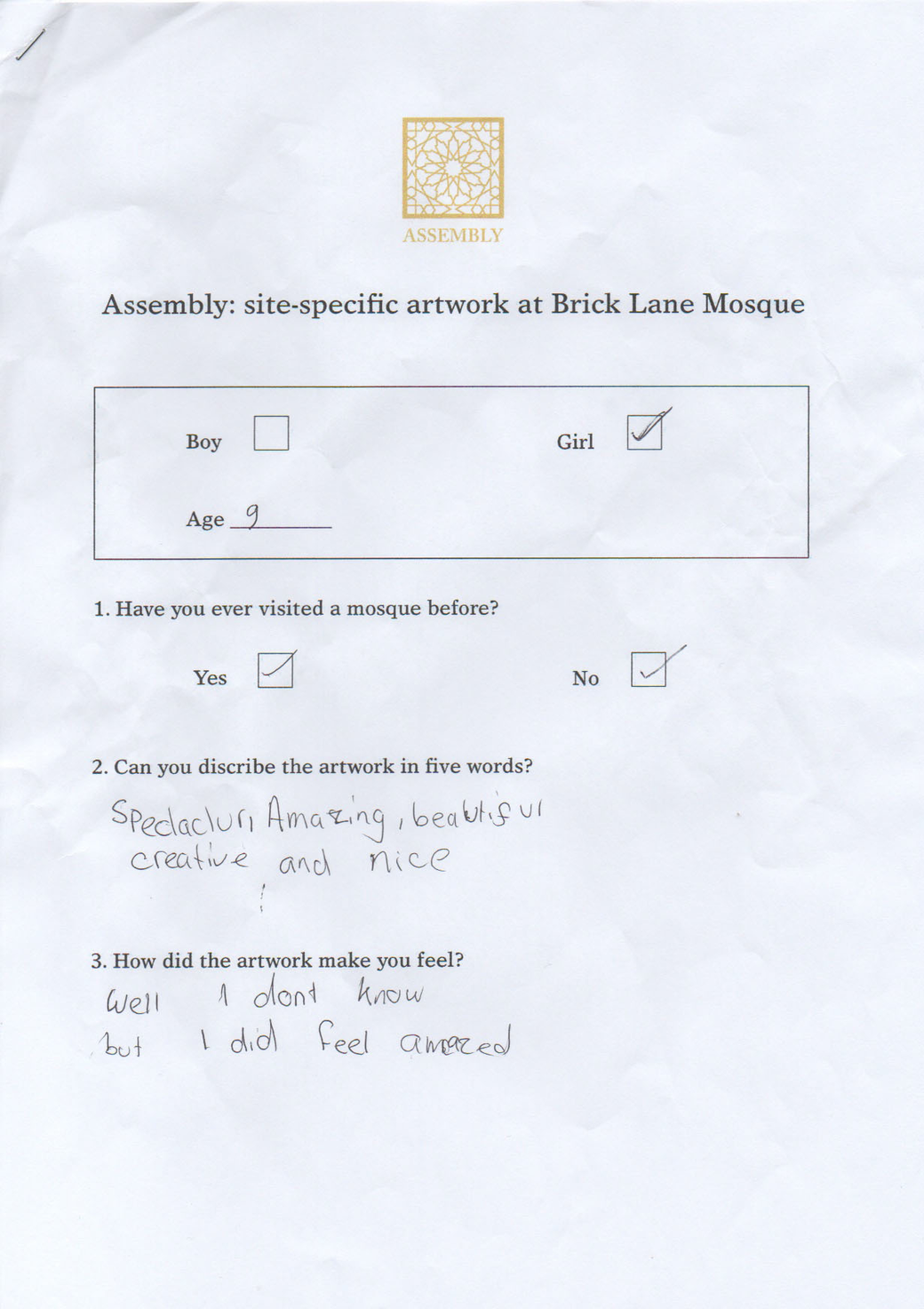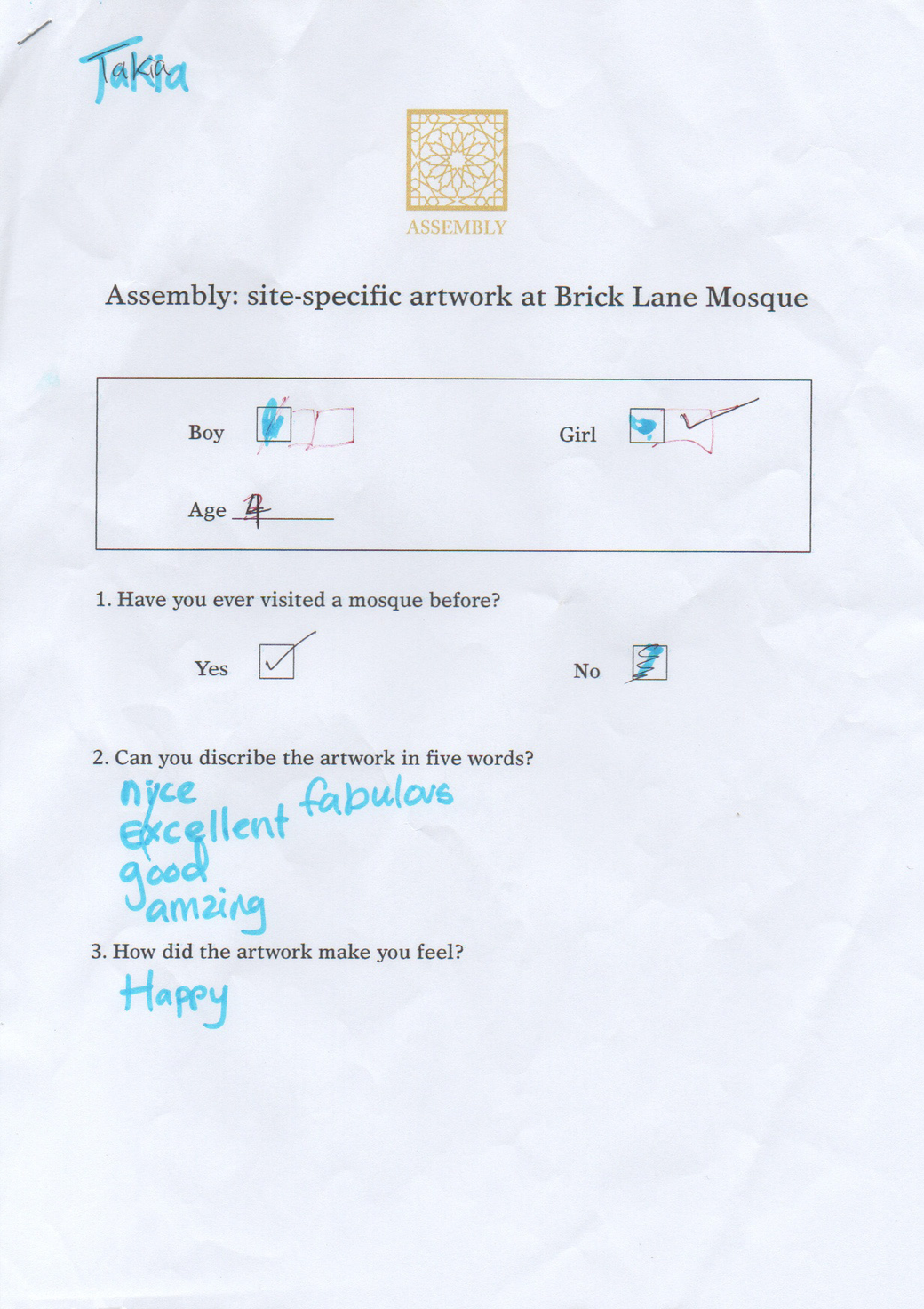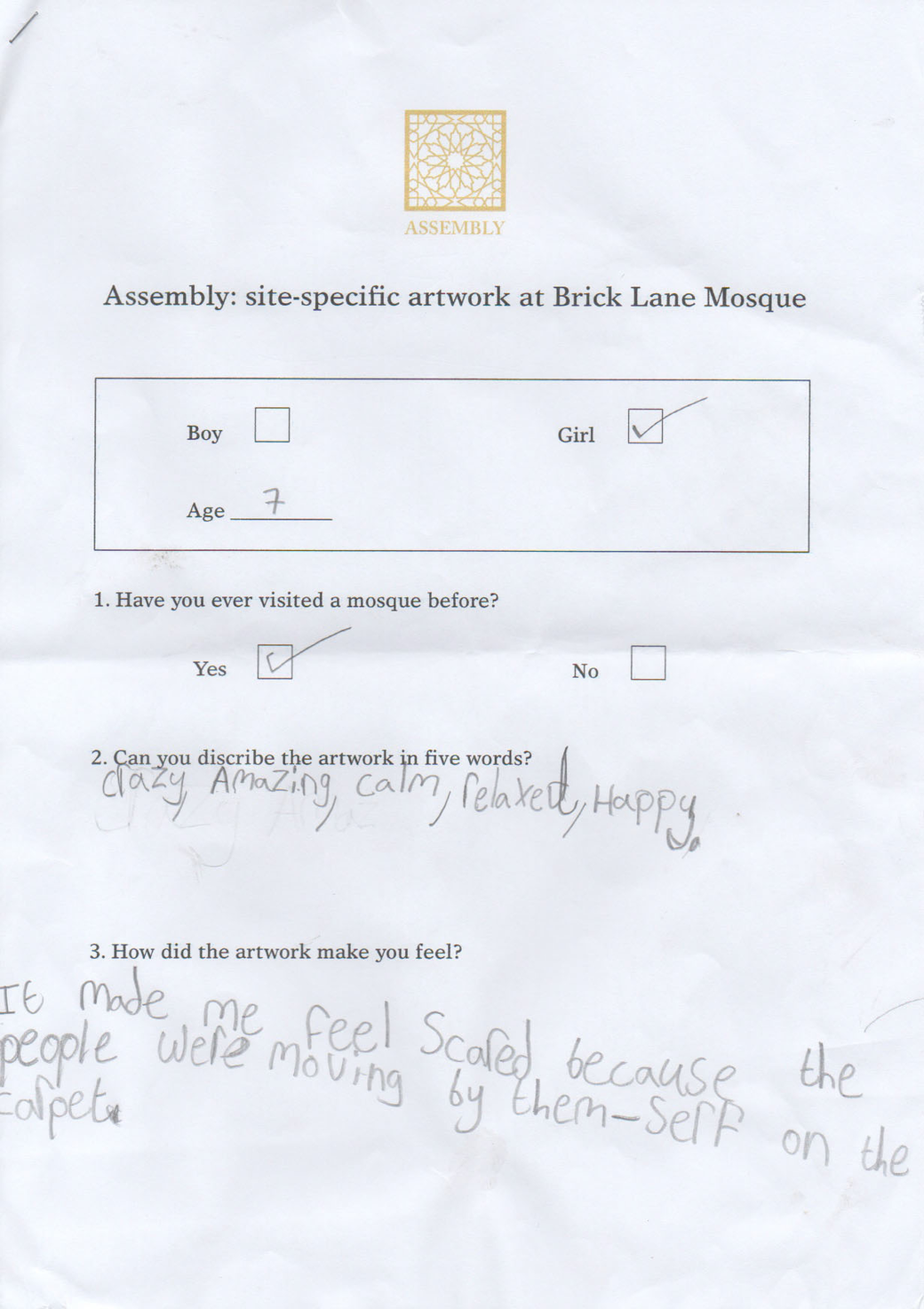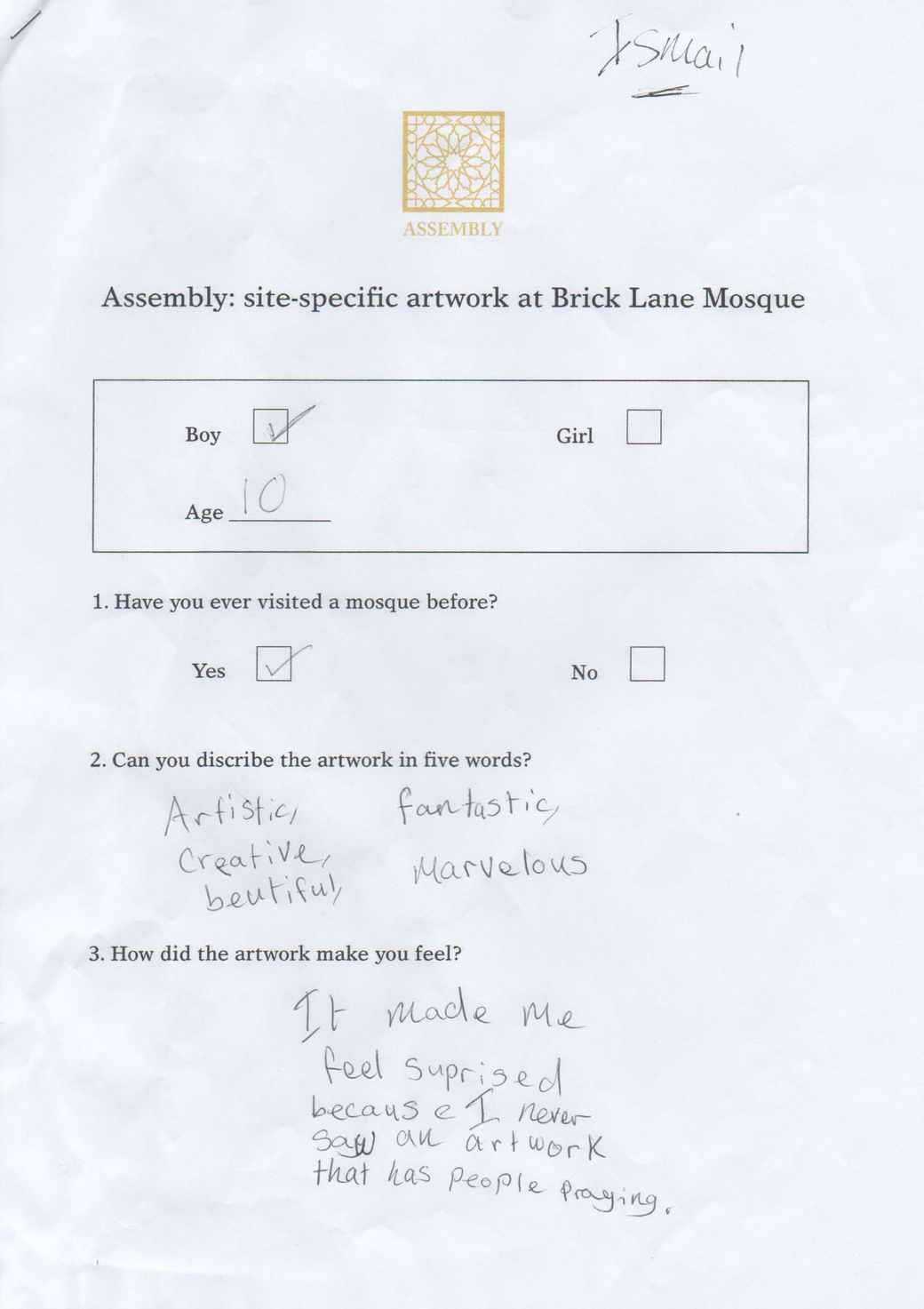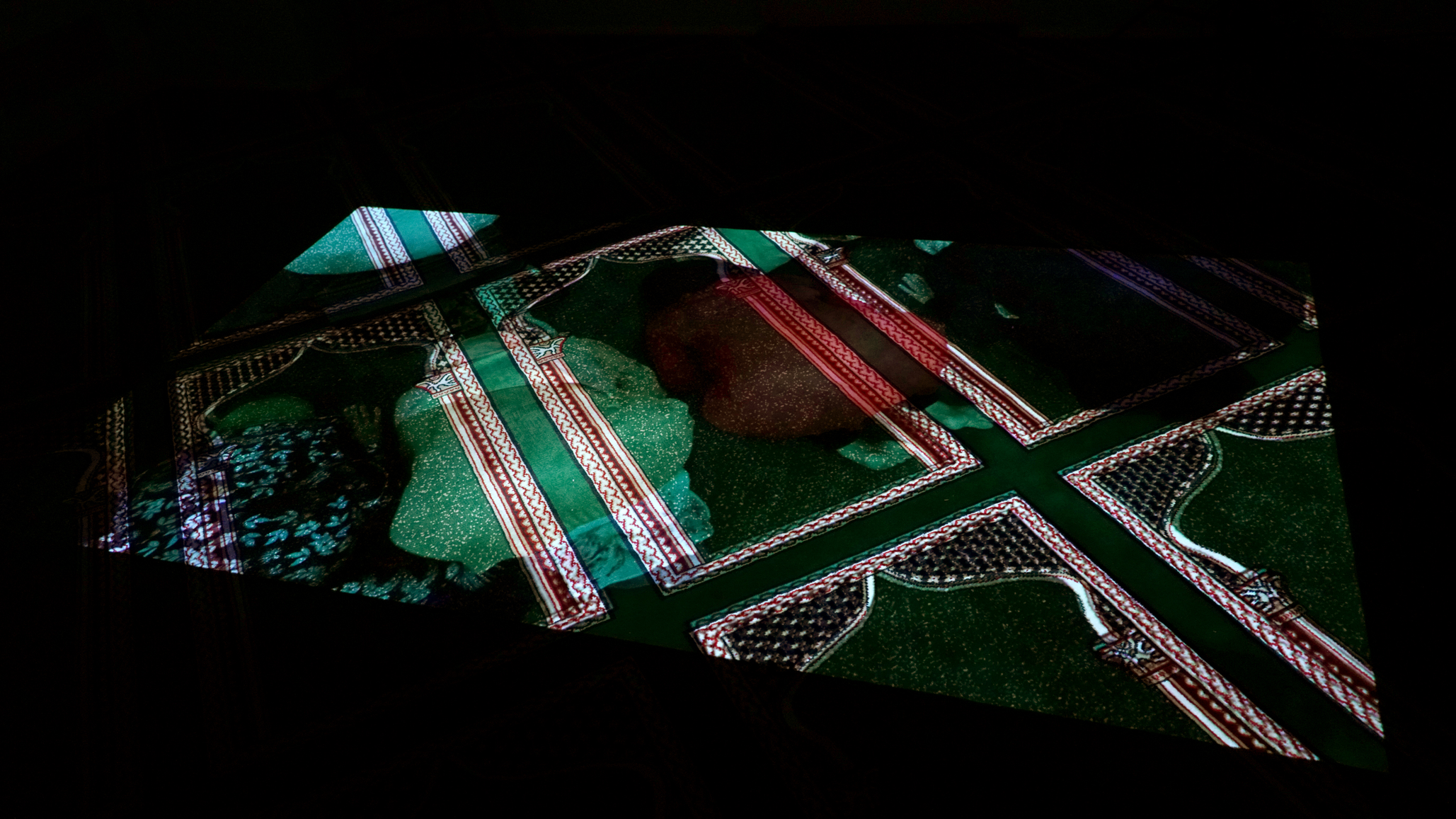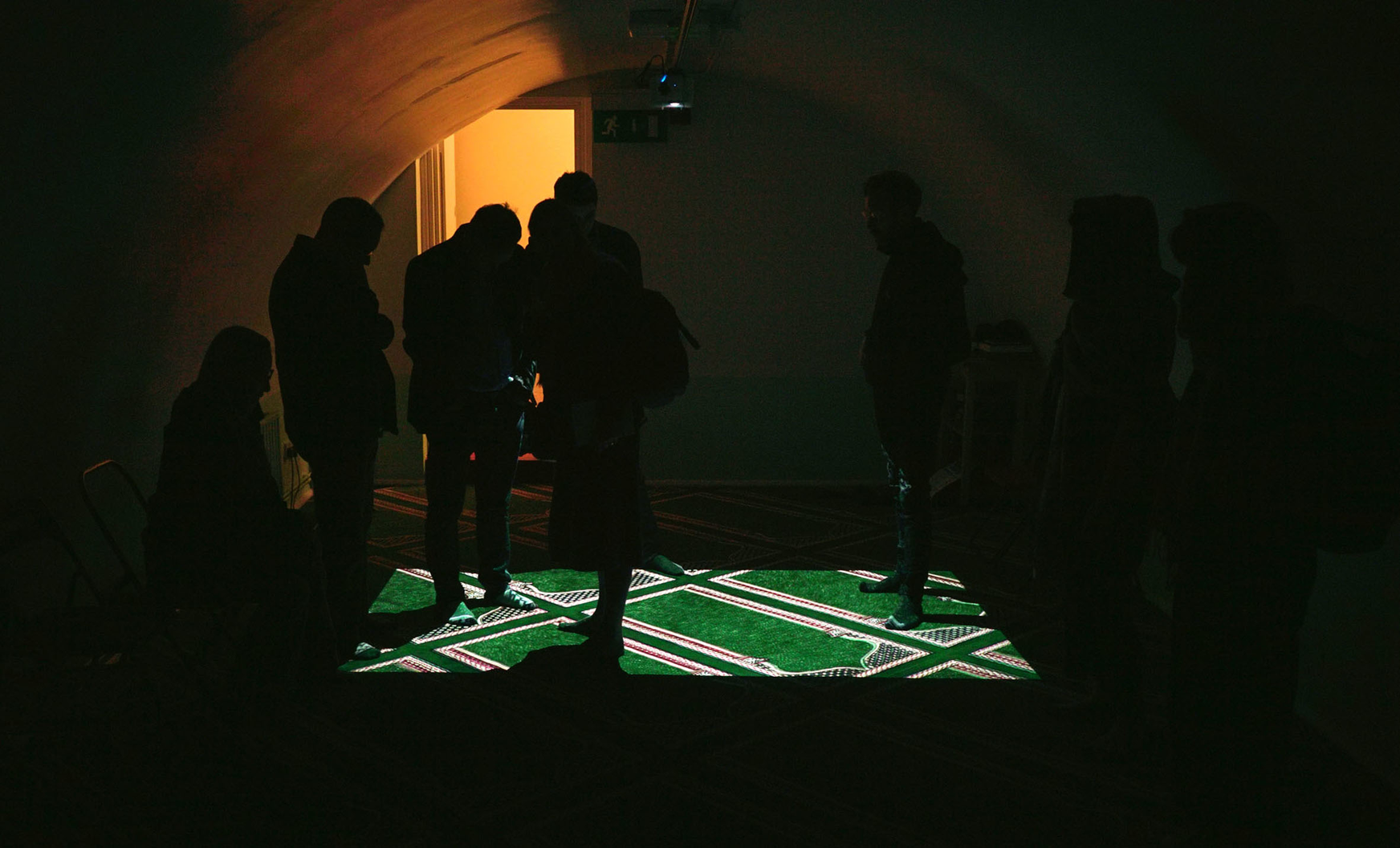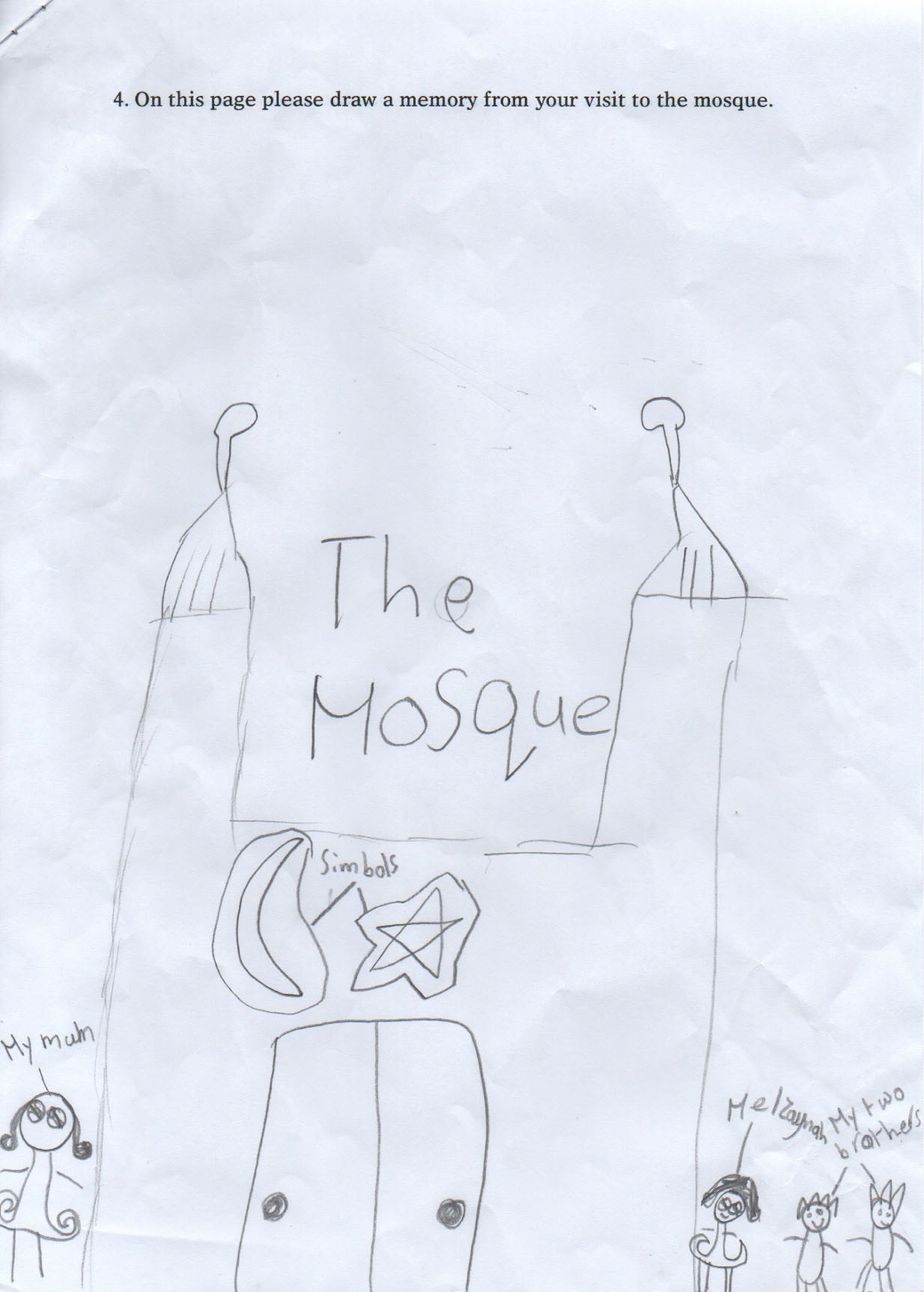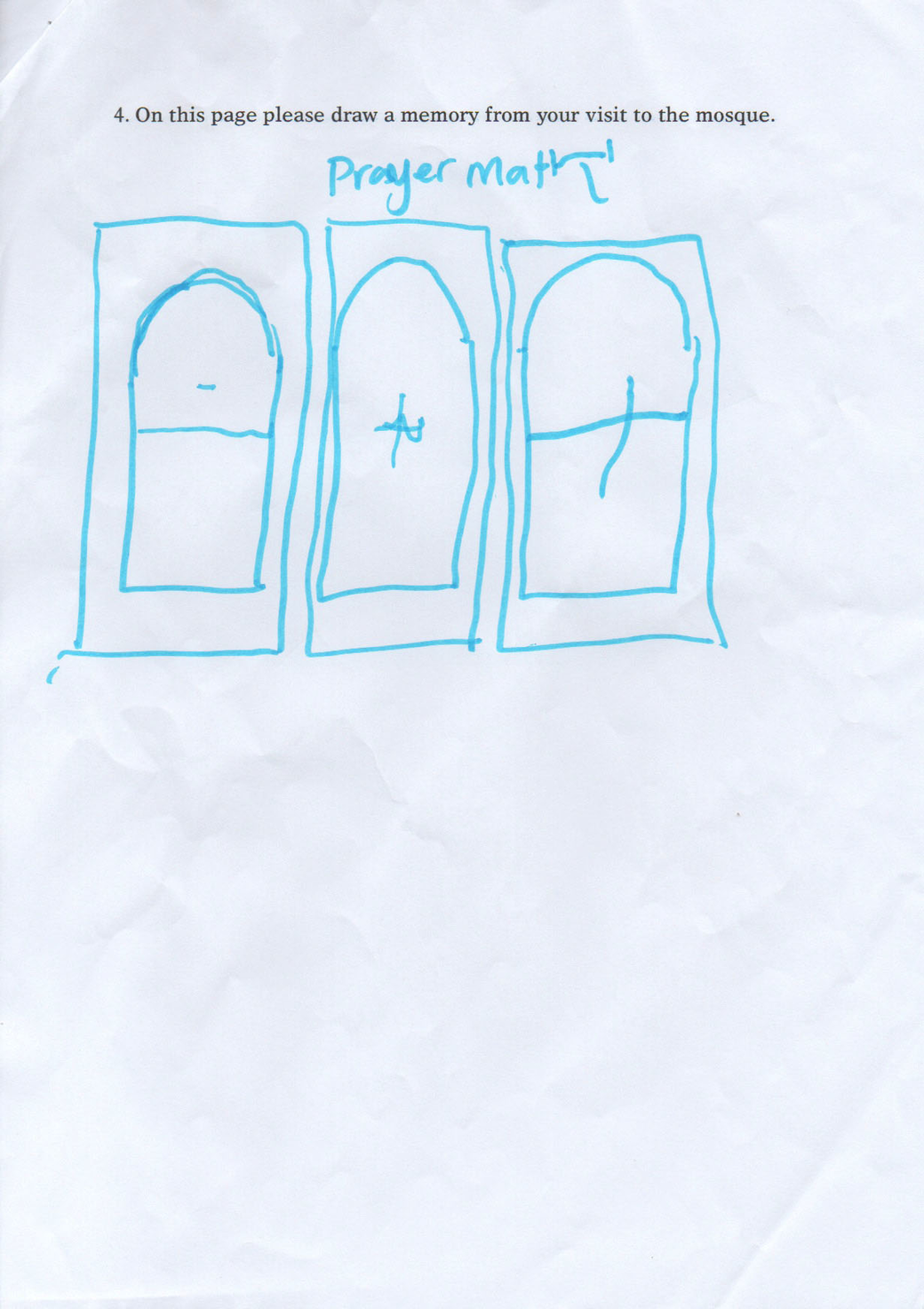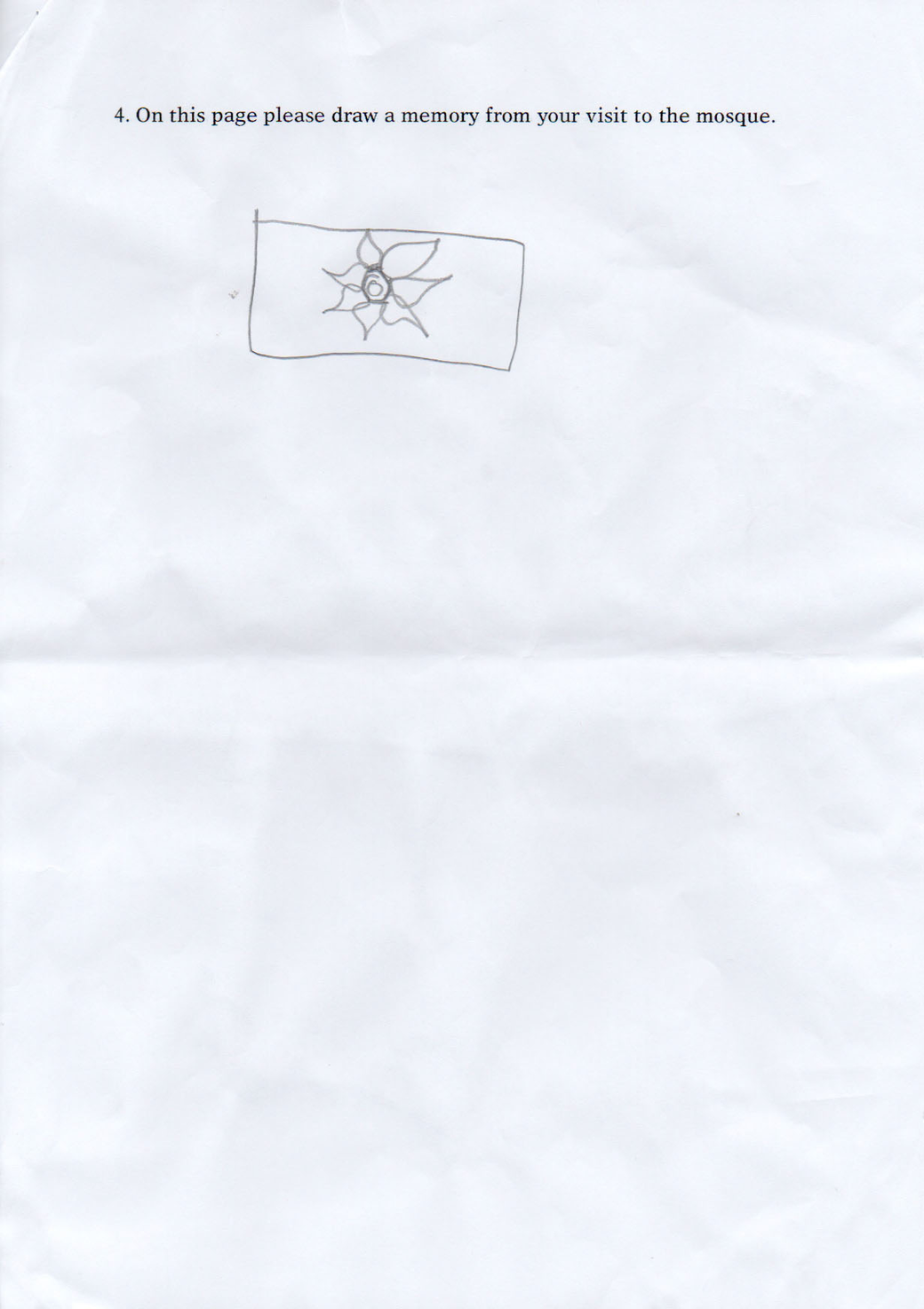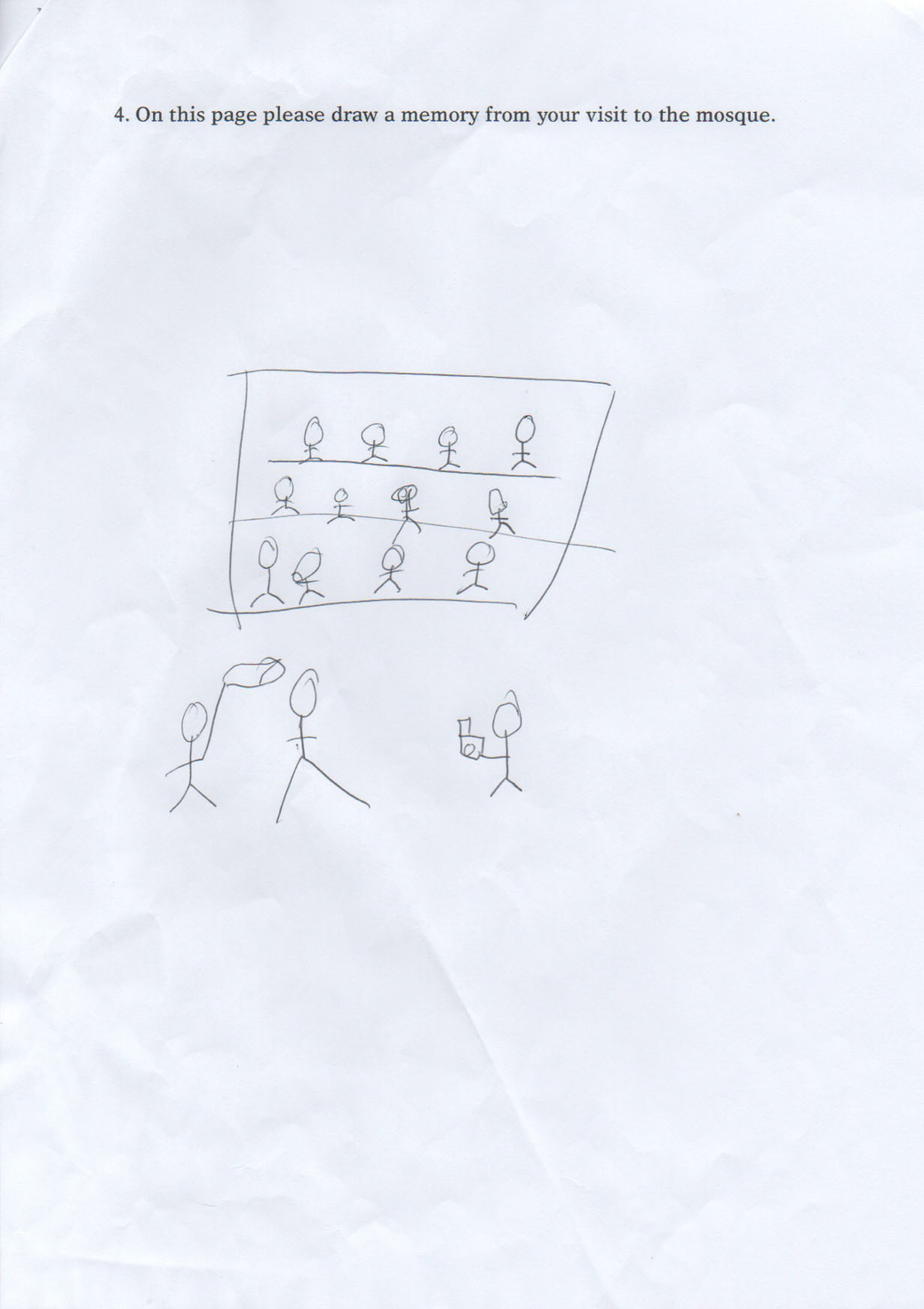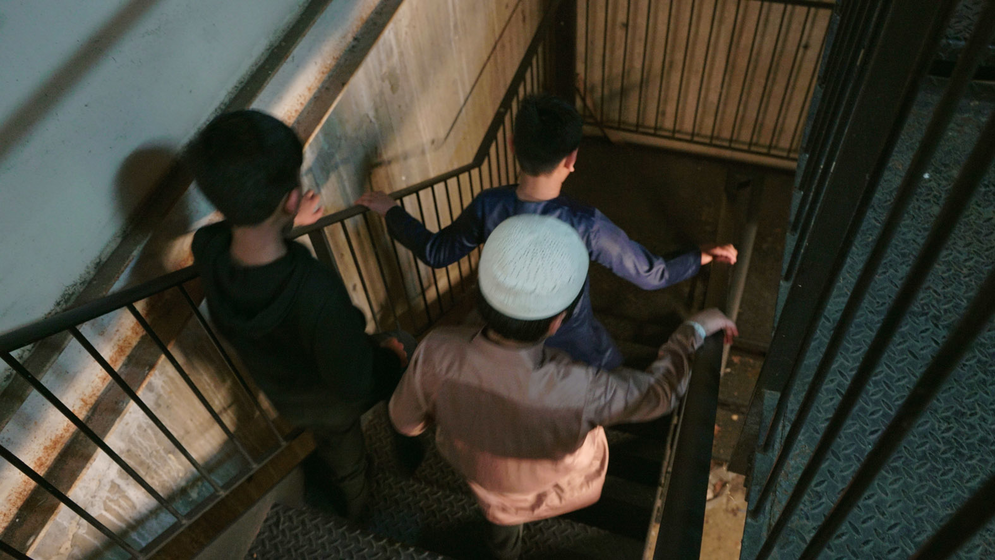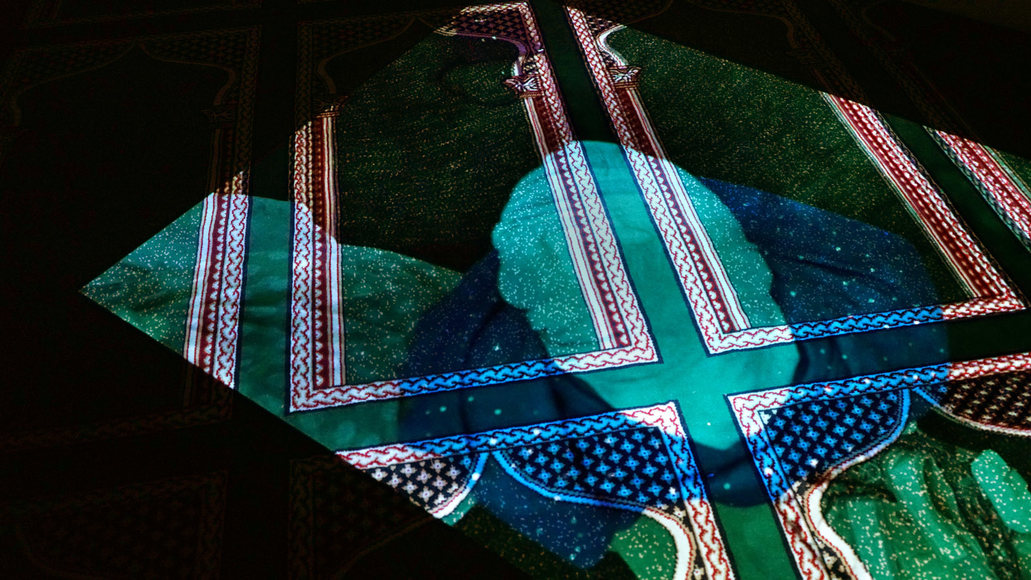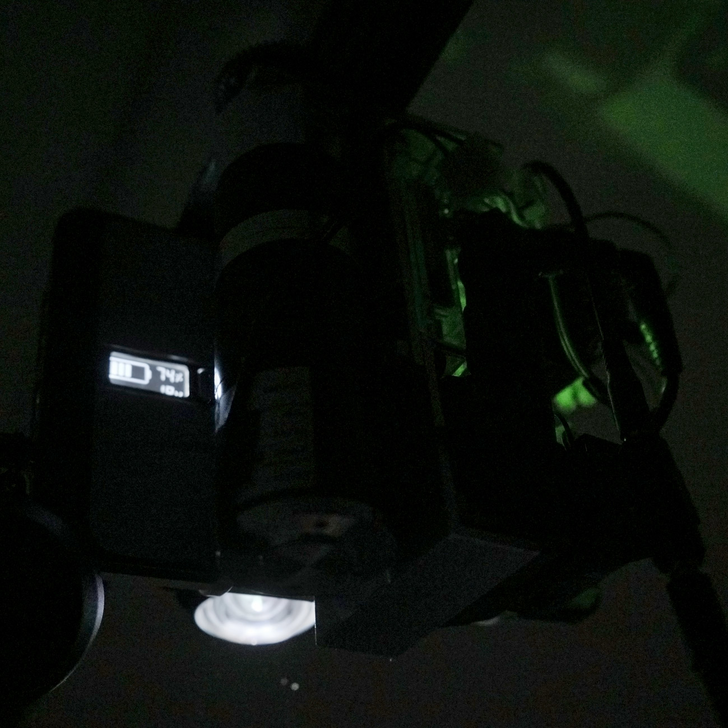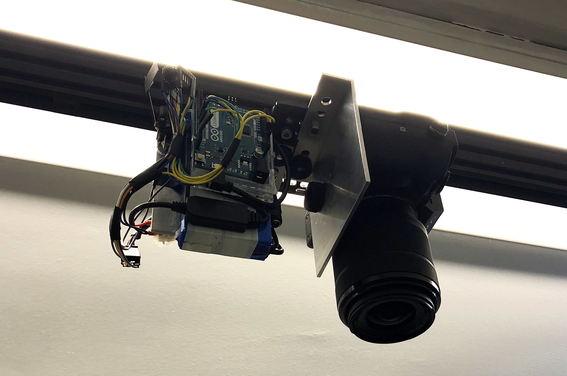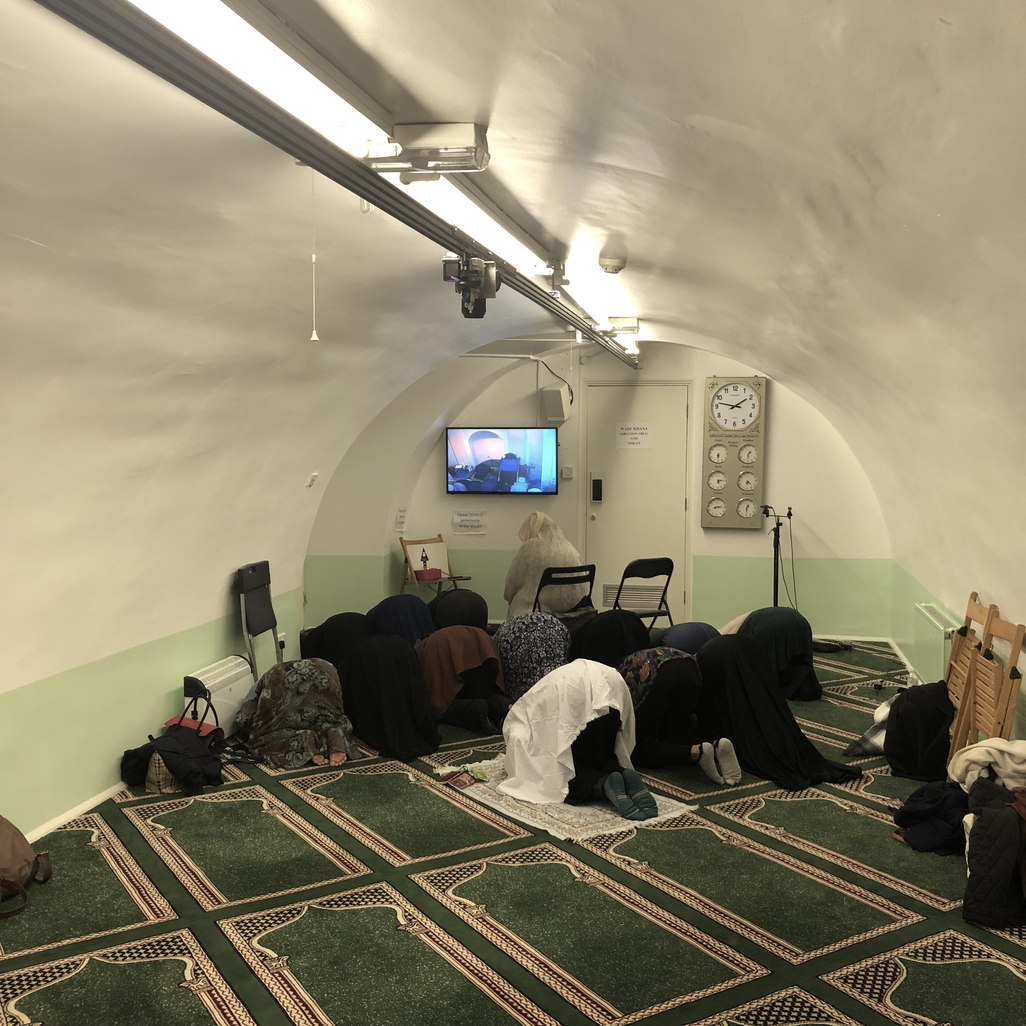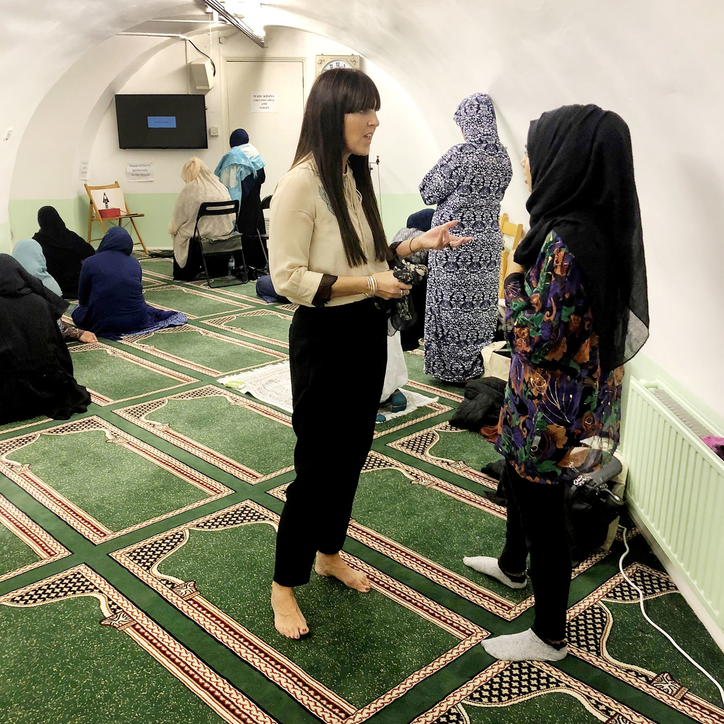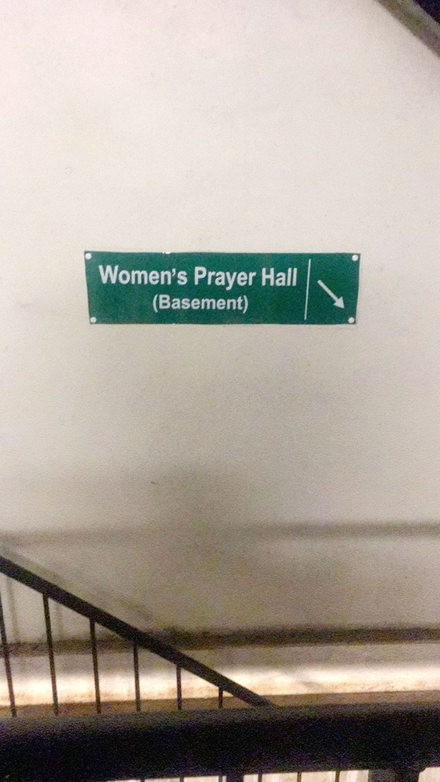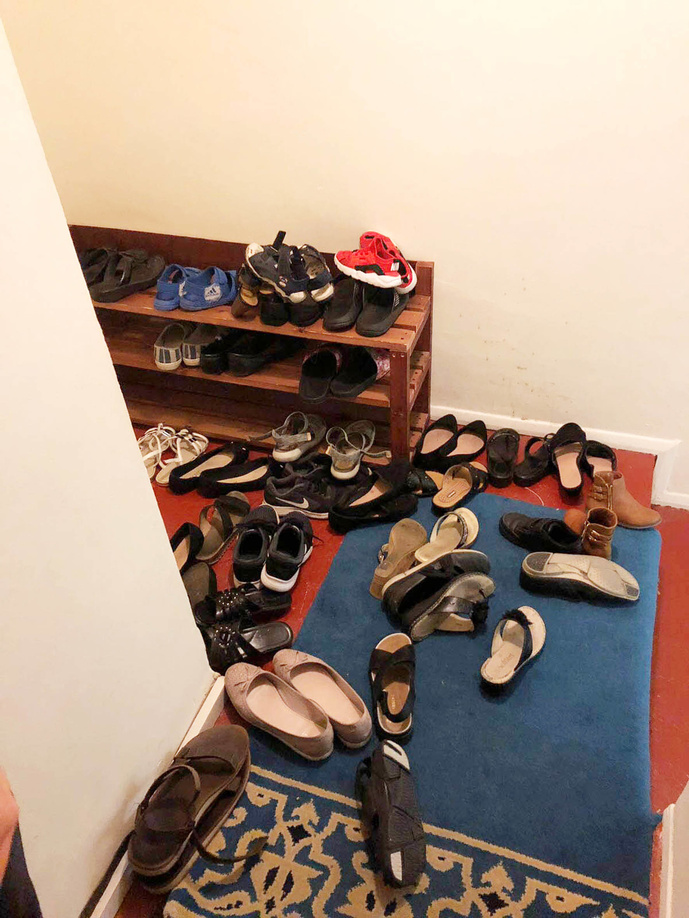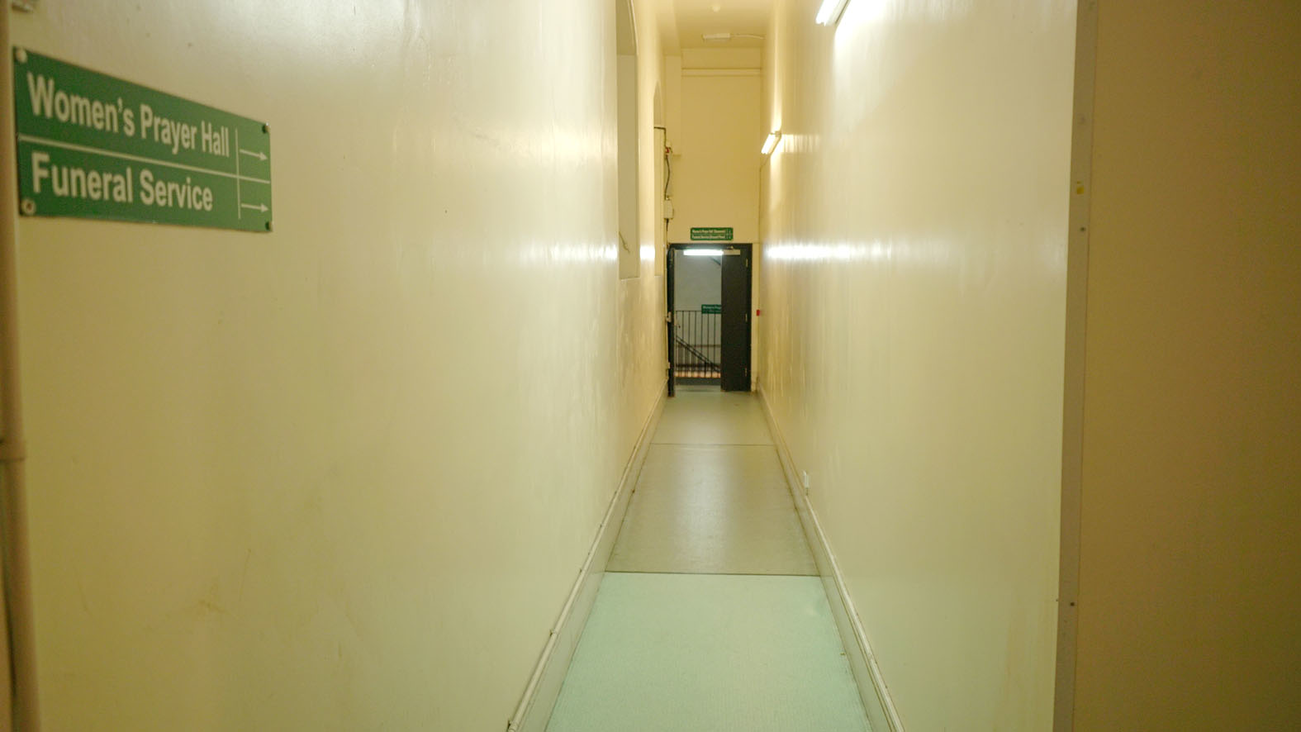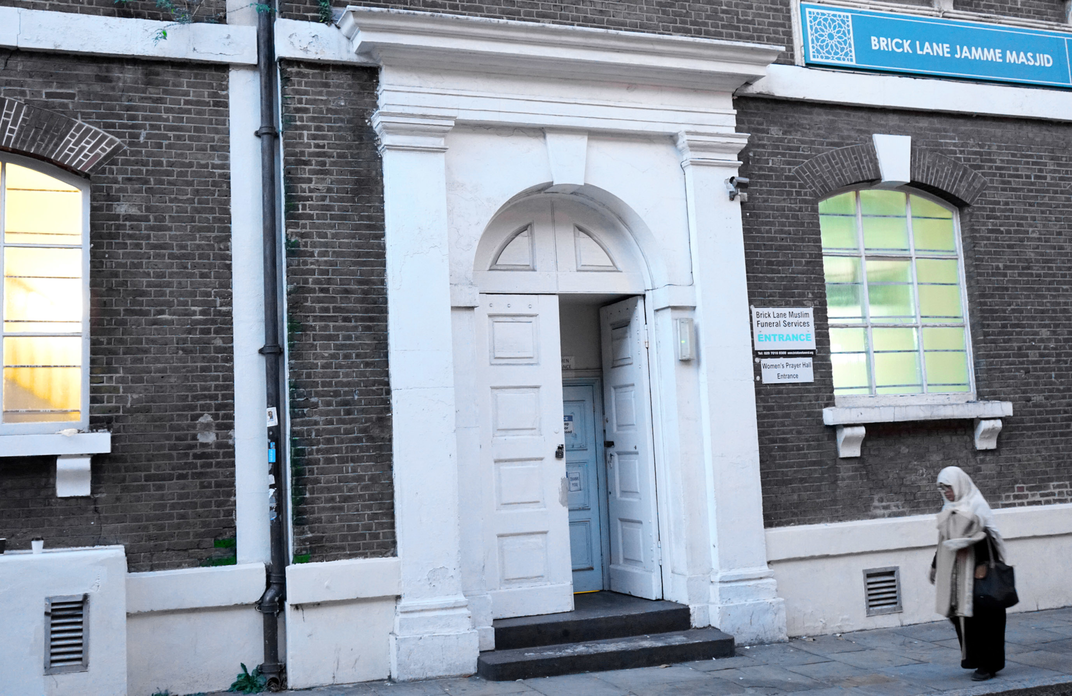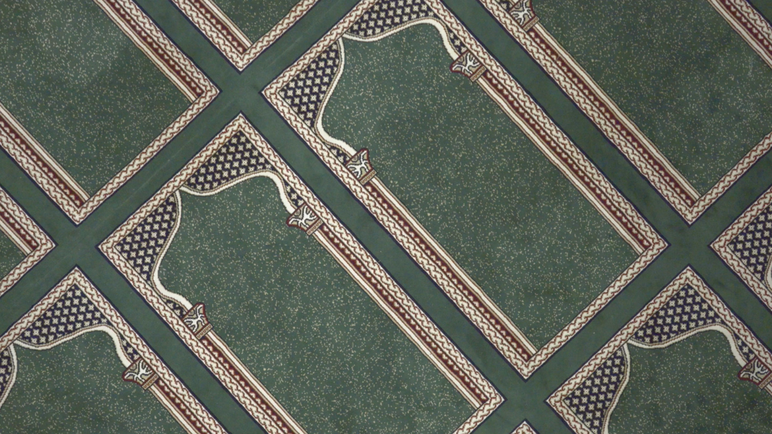PROJECT: ASSEMBLY
Assembly performs the materiality of Muslim prayer space via moving floor projections with surround sound. As the audience enters each prayer site the projection is activated, revealing a pre-recorded film of congregational prayer. The digital moving image hovers improbably above its ‘real’ counterpart, providing an opportunity to experience prayer in situ, via the site-performance.
Assembly investigates the role that artist fieldwork can play in engaging and connecting communities, as well as exploring the religious, cultural and social structures that exist in Islamic sites of worship. Each site-specific artwork is made in collaboration with the community, respecting the religious and cultural rules of each specific site. Automated mechanical recording devices are used as an anonymous eye; in a culturally sensitive environment such as the mosque, the objectivity of the machine allows entry to a place that is forbidden for a female non-Muslim. Research into Muslim sites of worship has often been conducted as theological and sociological studies, which neglect to acknowledge the performativity of Muslim prayer. Assembly aims to address this through a series of site-specific artworks that directly engage with the materiality of site and its community.
“The soundtrack to salat purposefully records the sound in place – the sound of the Imam reciting the prayer to the faithful, contrasted with the dispassionate camera lens staring intently at the Mosque Carpet, with real people living real lives in a real unfettered environment. This is quite elegant: quite beautiful and deeply emotive.”
The Georgian building, acquired by the Bangladeshi community in 1976, was built as a Huguenot church in 1743 and was then converted to a Methodist chapel, then a synagogue, before its current use as a mosque.
Jamaat (main prayer hall)
Made in collaboration with the Brick Lane Jamme Masjid community, Jamaat comprises of two simultaneous installations, one in the main prayer hall and one in the female prayer room. Automated silent mechanical recording devices are used as an anonymous eye; in a culturally sensitive environment such as the mosque, the objectivity of the machine allows entry to a place that is forbidden for a female non-Muslim, such as myself. Directional microphones capture the Jumu'ah service and the ambient sounds in the main prayer hall during the Friday congregational prayer. The film and soundscape is then played back into the space via the automated rig and the surround sound system installed in the mosque.
At the end of the project the Jamme Masjid invite the general public into the main prayer hall and female prayer room, providing an opportunity for Muslims and non-Muslims to experience Jamaat first hand via the site-performances. The research set out to ask the following question, how can art act as a platform for debate and discussion within Islamic sites of worship?
The term Jamaat (Arabic: جماعتِ meaning Assembly) can apply to the following: Jamia - a gathering or congregation; place of gathering. It feels appropriate therefore to title the work Jamaat, as this work is not concerned with the individual (the salat) but the congregation as a whole.
Jamaat is made respecting the religious and cultural rules of the mosque and is exhibited following the same rules; the camera is not permitted to film in front of the people praying, nor can it show their faces. Subsequently, a mechanical rig is constructed to film from above, at a constant speed from the entrance to the Mihrab.
Pre-recorded footage of prayer is then projected back into the architectural sites using the same automated device. The controlled motorisation of the projection re-traces the movement of the recorded image, giving the effect of only the frame moving through physical space, constantly revealing and concealing the actual site below.
In Jamaat the pre-recorded image content is a vital component of the experience, as it is a re-projection of the exact architectural space. The way that the projected image of the carpet matches the scale/proportions of the real carpet makes for a visceral and direct corporeal relationship between the spectator and the site. Using pre-recorded imagery of the same architectural space allows the nature of the two events to become significant content, in the space between the image and the projector. The pre-recorded footage of people in prayer projected back into the architectural space prompts the audience to question what is real and what is illusion. Naturally, the audience questions how the representation relates to the real space and how the experience of the real space is mediated by the image.
"It was a very special and moving experience, especially the way the congregation interacted with us, it was very beautiful how they welcomed us into their space." (Audience feedback)
"The madrasah pupils gained a sense of belonging and pride as they show the visiting children ‘their mosque’ while the local school children learned about Islamic faith and culture." (Audience feedback)
"I was always curious to see and know what was taking place, but it was obviously a strict no-go area. Having the opportunity to witness prayer through Jamaat, and not feel as though I was intruding was really incredible. I found it a rare, meditative and moving experience." (Audience feedback)
Birmingham Central Mosque, one of the largest mosques in Western Europe, was built in 1969 and opened to the public in 1975. The most inspiring value of this mosque is its Multi-denomination position which means it does not belong to any one particular sect or school of thought but it represents all Muslims from any background.
As an artist, I was granted access to make the work, but at the same time, as a non-Muslim and as a woman I was denied access to the mosque during prayer. This demonstrates the complexity of negotiation in terms of engagement with the materiality of a space, when that space is determined primarily by strict codes that are based on ideological restrictions.
“The projected image makes prayer appear even more tangible and real than reality itself. There is a heighted sense of the theatrical within this and seeing my own body in the film is fascinating, i've never seen myself in this light before." (Congregation feedback)
The presence of people in the footage involves a shift in representation, from a focus on the viewer’s relationship to the architectural site, to watching someone else’s relationship to place. These layers of interaction perform this research on place.
“Experiencing the image of my own body over me and feeling it physically move over me was a strange feeling, I was made more aware of the space around me.” (Congregation feedback)
"The projection opened my eyes to the physical act of prayer. Of movement and repetition. Because my view or senses are often fixed on a focal point (the imam), I didn’t really consider my own movements. But of course, in the core of Islamic thought, it is the worshipper’s movements that are essential and none others." (Congregation feedback)
Salat
Salat is made and performed in collaboration with the Birmingham Central Mosque congregation. The research proposes a new approach to site-specificity; a collaboration between community, artist, machine and site. A key concern is how the collaboration between artist and congregation can inform much of the decision-making around production.
Salat brings forth a precise relationship between body and space, helped by the fact that the people it addresses are coming to worship and therefore invested in the place. The congregation question how the projected image relates to the real space and how the experience of the real space is mediated by the image. Salat challenges ideas about what happens in a sacred space, as the worshippers physically re-orient themselves to their own image, witnessing the projected image of their body move over their physical body in the site. It could be argued that there is already a form of site-integrity in the mosque because of the religious and social practices that happen there. How much are the religious practices responsible for defining a mosque?
Salat enables a mind–body experience of the architectural site that is influenced by the simultaneous reinforcement and subversion of habit, haptic experiences, physical limitations and culturally constructed ideas. The experience of the work can be informed by what we habitually and haptically know about the architecture of the site, but it is also unrestrained by the physical body and physical world. We can imagine touching the carpet, informed by what we know about the physical texture, colour and material of the real carpet – simultaneously heightened and challenged through the projected image.
Ontologically there can be no split between representation and the real, however we experience the ‘realness of the real’ and the ‘image-ness of the image’ and Salat pays attention to this. This sense of illusion is strengthened as the projected image physically moves through the architectural space; the experience becomes spectacular in nature. It can be argued that this engagement with the spectacular is exactly what helps draw the spectator’s attention to their relationship with the architectural space and, specifically, perception of place.
“Watching the boys playing with the projection is fascinating. The dipping in and out does not actually disturb the thing as material or the thing as image: it actually performs both at the same time and shows how we come to be ourselves as ethical beings through figuring out how things feel on our bodies, not by adhering to strict code.“ (Congregation feedback)
“I loved seeing the children playing in and around the films and I loved Stella’s friends clearly being both proud to show her round the mosque and also simply enjoying being together.” (Audience feedback)
"The installation in the female prayer room feels like a very accurate representation of my experience – the overwhelming sound with a focus on a partial area of flooring. What is even more apt is the sense of both confined space and everlasting space – the knowledge that a mosque acts as an infinite space, but you shone a light on one row, as it where, enough to have a communal feel.” (Congregation feedback)
The importance of sharing cultures and establishing deeper relationships within the younger generation was evidenced during the local school visit where over 40 primary school children, staff and parents visited the artwork. After the site-performance the children filled in questionnaires, providing their reflection on the event.
"There was something very interesting happening with the projection in the woman's room where not only did the image seem ghostly and ephemeral but also deep. It almost seemed as though the image was being projected into the carpet rather than onto it. Maybe it had something to do with the light or the low ceiling which enhanced a downward looking, the effect summoned thoughts about the vertical space / vertical energy / vertical light / vertical bowing (up and down) action during prayer and how these synced or became extended in the projected image." (Congregation feedback)
"The surrounding darkness in the women’s prayer room projection felt like an ode to the building’s former haunt as a church – where I would normally identify churches as more accustomed to darkness/limited lighting." (Audience feedback)
In Jamaat the pre-recorded image content is a vital component of the experience, as it is a re-projection of the exact architectural space. The way that the projected image of the carpet matches the scale/proportions of the real carpet makes for a visceral and direct corporeal relationship between the spectator and the site. Naturally, the audience questions how the representation relates to the real space and how the experience of the real space is mediated by the image. The projected image appears to be multi-layered, as the image of the carpet maps perfectly with the real carpet, whereas the bodies in prayer become ghostly illusions.
The silent automated rig witnesses an experience than could not have been captured by the human eye. The mechanical eye allowed access to the sacred moment of prayer where focus to worship needed to be central and the camera non-intrusive.
Valuable feedback was gained from the mosque community and the Inclusive Mosque Initiative. When discussing the project trustee Naima Khan stated, "We would like to use this opportunity to challenge the perception that mosques like IMI [Inclusive Mosque Initiative] exist in opposition to other mosques (and vice versa) when really, we can coexist in a peaceful, productive way."
The LCD monitor in the female prayer room is a portal to the main prayer hall and links both sites in space and time. As the prayer starts the LCD monitor and speakers are automatically activated and link the two spaces via image and sound.
Jamaat (female prayer room)
Made in collaboration with the Brick Lane female congregation, Jamaat comprises of two simultaneous installations, one in the main prayer hall and one in the female prayer room. Jamaat has found a way to connect and engage both prayer spaces, allowing access for men and women to both sites. As this research project has evolved, the relationship between the two prayer spaces has become a fundamental aspect of the work. The two sites are so different in location, size, atmosphere, yet they are joined by the performance of worship.
Within this space I worked in collaboration with the female congregation and the Inclusive Mosque Initiative (dedicated to creating places of worship for marginalised Muslim communities, spiritual practice and the promotion of inclusive Islamic principles) and the female mosque community to help gain valuable feedback into the ethical development of the project.
